#MV analysis
Explore tagged Tumblr posts
Text
"Black Out See Saw" is the Climax Alkaloid Deserved
Top Songs from Enstars 2023 Number 1
I was blown away when the album art for Alkaloid was released a few months ago...
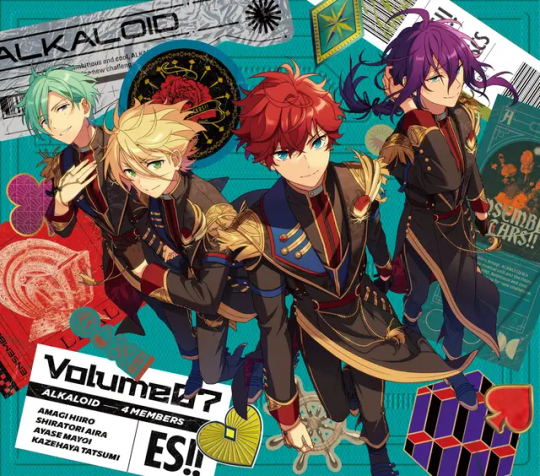
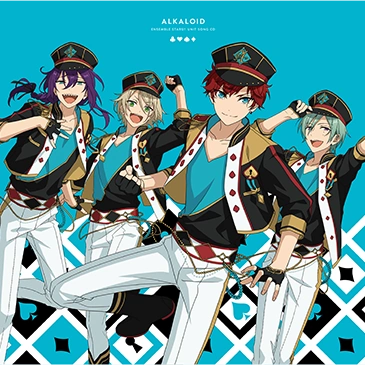
This art is such a sharp contrast from their first album art, that shows how they have grown. The basic military style unit outfits have been replaced with regal commander-style ones. The basic emotions that are shown in the original are now much more refined- in particular, Aira has evolved from someone simply happy to be on a stage to someone who is confident in his place on it, Mayoi is putting himself more in center, and Hiiro's confident smirk has become more stoic, as he now has the experience to go with his skills.
All of this went away, however, when we actually got the Alkaloid Climax song...
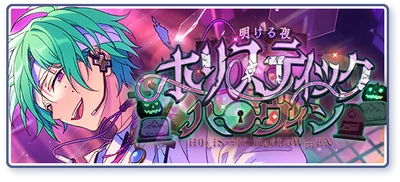
Sigh...it was the seasonal Halloween event for the year. Yes, the idea of incorporating hospital/illness and Tatsumi's relationship with it is an interesting story to tell...but Alkaloid deserved so much more, especially as the "Protagonists" for the !! era of Enstars. I was frustrated that the end of this era of Enstars for Alkaloid was wasted on a seasonal event, but was at least able to take solice in that Alkaloid gets 200 chapters of the main story dedicated to them, and we still had solo songs for each character to come from the album. December rolls around, and the album releases. After jumping through hoops to buy it, I throw my headphones on to give the album a listen. The first track, "DiZZineSS" is a weird 30 second preamble with no singing, not something I was expecting. However, it rolls directly into the first new song on the album
Bam
Black Out Sea Saw is a violent wall of sound, unlike anything else that has been done for Enstars before, and I can understand fans not liking it. The reason it sounds so different is because it was produced by TK of Ling Tosite Sigure, a 20+ year going Prog Rock group. I listened to the song 3 times before moving on, and waited for the MV release to come, as is usual with the "B" side track from Albums. And what we got was one of the most well constructed videos for Alkaloid fans, and the climax that I was looking for that wasn't provided by the Halloween song.
The video opens...strangly, especially if you haven't heard the song before. The opening is intentionally choppy and rough, almost like it was an unfinished song that still needed production. There is a weird reverb effect happening- which you can especially hear when Mayoi hits the high note, that led to a friend saying "it sounds like they recorded this in a bathroom or something". The other thing that really jumps out is how robotic and synchronized the movements of all 4 members are. This is a BIG deal. In just about every Alkaloid video, you can find little inconsistencies at various points- Aira is sometimes a bit slow to do something, Hiiro is sometimes a bit too fast, Tatsumi's movements are less athletic, etc. The robotic movements are all in perfect unison, especially at points where characters do things together, like make hand bridges. It's a sign of Alkaloid's growth as a unit- they started as a collection of rejects, and now they haver come together and become a great unit together.
As we go to the first chorus, the intensity of the song ramps up- it becomes FAST, yet every member is in perfect harmony. The dancing becomes more intense- and everyone stays perfect. And then we get to the final line "It's Error-Error", and things start to change- we start to see more finger movement, the motions become more flowing and less robotic (the robots are malfunctioning! error! error!), and more personality is shown by each member.
We then get a wonderful effect of feathers raining from the sky, before, and then we get to see everyone smile, including Hiiro with this soft and expressive look. (that I wish I was able to time slightly better when I took my screenshot!)
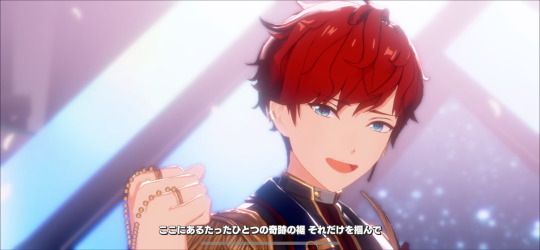
Why is this important? Lets take a look at the first Introduction of Hiiro, in his first close-up in Kiss of Life
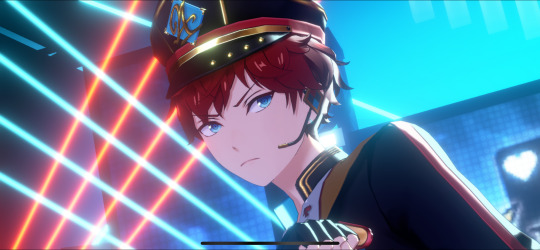
It's a look of focus, of determination, and NOT one of joy. Hiiro NEVER smiles at any point in Kiss of Life except during the SPP- he maintains a focused look the entire time. Additionally, you can look at just about any Alkaloid video, and Hiiro rarely smiles- if anything, he just physically assaults the camera in every one of them! The final chapter of the main story is titled "Smile", which is a discussion between Hiiro and Rinne on what it means to be an idol, and Rinne telling Hiiro "Whenever I see you smile, it makes me smile too", with Hiiro responding that he will do whatever it takes to make people smile


Hiiro wasn't able to smile in Kiss of Life, as his focus was on putting smiles on the faces of others. It's weird, because when he isn't preforming, a smile is basically plastered on his face permanently. He has a very loud and infectious laugh, and he's just happy to be doing anything at any time. On stage, for him, its different. And Black Out Sea Saw is the first time that Hiiro is able to not just smile, but show kindness in it, as opposed to simple joy or excitement. It's a MASSIVE step forward for him- the kind of thing that, you know, you might build a Climax story around?
And then, we come to the end, where the intensity of the song does not let up, before it all crashes to an end as the lights go dark and Alkaloid go still
To me, this is the Alkaloid Climax, the song that I will remember. They have gone from a group thrown together to a cohesive unit with a sound unlike anyone else in the franchise, and all of whom have had character growth. It's the one that they deserve going into the new era that is upcoming, and even has a level of finality to it, seeing as how it was released right at the end of the year.
Alkaloid deserved better than Undying Holy Love, and boy, did they get it...
#ensemble stars#alkaloid#hiiro amagi#tatsumi kazehaya#aira shiratori#mayoi ayase#black out sea saw#mv analysis#Enstars Climax#Best of 2023
125 notes
·
View notes
Text
An Analysis on the Literature Girl Insane MV!
Hey! You might not know me that much, as I’m not active in the DRDTheory community, as I’ve dubbed it, but my name is Blanket! Technically, this is a work of collaboration between the majority of DRDT Twitter, but it’s mainly just an analysis of stuff I couldn’t do by myself.
Okay, and now, onto the video!

So we start off with the spoiler warning. Pretty standard stuff, of course.
Many of my theories beginning here will be based on the colors and what I, personally, associate them with. Of course, the actual MV’s contents will be looked at further down the line.
As a bonus, take note of what pops up right after that. It’s a question: Do you want to forgive... someone? We’ll answer this question later on in the theories section.
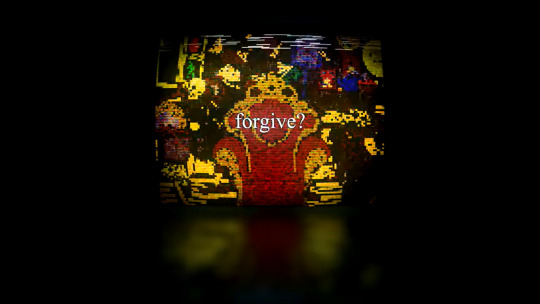
These are mainly just lyrics, but the “final verdict” part catches my eye, as I believe it isn’t in the lyrics further down the line. Perhaps it’s about the current trial? As many people believe, David did not kill Arei. His reasons for lying about doing so are unknown, but we can assume that the singer is calling the listeners idiots, because of their incorrect final verdict. Whatever David wants to do, it’s certainly not leading them to the right one.
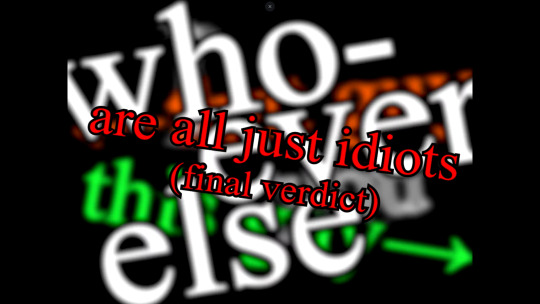
Next, these lyrics. While I believe it’s fairly obvious that the pink is meant to represent the typical Danganronpa-esque color of their blood, the color that the word “game” is in is probably relates to David. After all, his hair clips and star eyes, both prominent features of his “facade”, are in the same color.

Here is where the most prominent part of the MV is, to me. The text that flashes across the screen during transition points. The first one, in white text, is an excerpt from Osamu Dazai’s “The Flowers of Buffoonery.” The book, while I’ll spare you the greater details, greatly describes themes of suicide. The story’s main protagonist, Yozo Oba, can be described as so: “-But the narrator, a self-conscious writer, makes frequent first-person asides, breaking the fourth wall as he comments on the quality or believability of the novel he is writing.”
Something especially telling is this line, from an analysis of Yozo’s character. “Yozo is a person characterized by shame. Although I pretend to be someone who is confident and unabashedly themselves, that is not really true. I have always been ashamed of who I really am. I created a whole persona to interact with others because I believed my true self would never be enough.”
David’s character is someone very similar to that. Someone who has created a false persona to interact with others. Yozo is someone who feels resentful of other people, simply because he is forced to make them happy. “Yozo Oba is the tortured author and unreliable narrator of the three notebooks that comprise the bulk of No Longer Human. [That is the sequel to The Flowers of Buffoonery.] His appearance is depicted in three photographs examined by an unnamed narrator in the Prologue. These three photographs correspond to his appearance in each of the three notebooks. As a child, Yozo is precocious by design—an impish child who uses his antics to hide his fear, shame, and inability to relate to humanity. These fundamental flaws carry over into young adulthood; in the second notebook, he is a handsome young man whose smiling photograph lacks humanity, betraying the depth of terror and isolation that his comical persona seeks to hide. In the third photograph and notebook, he is only 27, but his gray hair and forgettable appearance prevent him from being labeled an ordinary human being.”
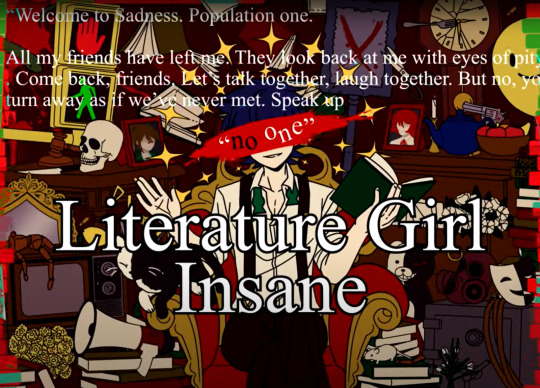
The quotes in yellow are from Agatha Christie’s “Murder on the Orient Express.” The full quote reads as follows. "If you confront anyone who has lied with the truth, they usually admit it – often out of sheer surprise. It is only necessary to guess right to produce your effect." I think the relevancy of this line in terms of David can be explained with his actions so far. Fun fact: Similarly to Danganronpa, “Murder on the Orient Express” is a murder mystery.

This is just a rickroll. DRDTDev thinks that they are FUNNY!? (They are.)

The “an archaic personal pronoun rarely used in real life, but popularized in fiction by the book” is most likely referring to thou/thy/etc. I’m not sure what this correlates to, but it’s probably important. I couldn’t find the green text, but from what I can tell, the green text probably relates to David’s nihilistic point of view towards humanity. Update: Bleuflower on Tumblr has located the source to be I Am A Cat by Natsume Soseki, so go check her out for that! If I had to say anything about that, it’d probably be relating to MonoTV, however, there’s also a continuation of David’s nihilism towards humanity that was also found in the Osamu Dazai references. The book itself is described as a “mordantly comic evocation of Sōseki's deep pessimism about his own humanity and indeed about humankind in general.”

The white text here is an excerpt from Osamu Dazai’s “No Longer Human,” which follows the same protagonist as “The Flowers of Buffoonery.” I’m sure you can all gather what that means in relation to David, but the main point is that he seems detached from his view of “normalcy.” @shidoutism on Twitter had this to say, as they’ve read the book itself: “OKOK so basically this first excerpt is from 'no longer human' by osamu dazai (its his last finished work because dazai sadly took his own life after publication of the book) now from the limited knowledge i have of david the meaning and message of the book might help in whatever analysis ur doing?? no longer human is about a man who never felt like he understood humans. like the title suggests, he never felt like a person. its revealed the protag was pretty sheltered and rich in childhood but experienced trauma from the familys housekeepers, but he never reported it. thats basically the start of it all as the protag grows up, he finds fear in communicating with humans. so he ends up either isolating himself and/or destroying all of his relationships with people. he's scared of people seeing the real him, so ever since he was a child he started putting up a happy, cheerful front. but it just creeped some ppl out bc it didn't feel genuine, it was more like a clown wanting to so badly entertain others. the protag starts resorting to bad coping mechanisms such as dr/gs and alc/hol and has many relationships with women to drown his sorrows and feel closer to being 'a human'. aaand the end of the book is kinda unsettling as the protag is sent to a rehab center and then when released, isolated himself somewhere far away without people, stating "everything passes. thats the one thing i learned in this living hell [somewhere along those lines]" and the book ends numbly like it feels like nothing”
I don’t know about you, but this sounds rather similar to our “protagonist.”

This quote is from “The Setting Sun”, by, you guessed it, Osamu Dazai. It tells a similar story, albeit with a different protagonist, but I feel like this ties in more with his facade, and how his inspirational speaking comes off to other people. Considering he is in his facade at this time of the MV, it’s safe to say that that’s what this is referring to.

And now, this all falls into place. These are the names of the Osamu Dazai books referenced in the text beforehand. The (I’m), next to No Longer Human, however, could signify how David views himself. Someone so sunken into depravity that they don’t register themselves as human anymore.

The faded text here is the first sentence of Yasunari Kawabata’s “Snow Country”. I don’t know what this refers to in terms of David, but this also seems important.

David still views himself as manipulative. Even if he does love people, even if he does have a semblance of care for those in his life, he views himself as an evil, irredeemable sack of shit, incapable of any emotion other than selfishness and cruelty.

This part is especially intriguing to me. David still wants to live, as anyone else does, but he can’t bring himself to find a reason to leave. His career is dead. He’s worthless, and nobody needs him around. Where would he go? There’s no room for him anywhere, even if he escaped, he’d just be shunned for good now that his entire life has been thrown away.
The excerpt from “And Then There Were None” by Agatha Christie, describes someone losing motivation to leave the island. The island is a metaphor for the building, that the students are trapped inside, and David has lost the will to leave in the first place. He doesn’t want to leave, because there’s nowhere else for him to even go. He doesn’t have a home. He doesn’t have a fanbase. There’s nothing left.
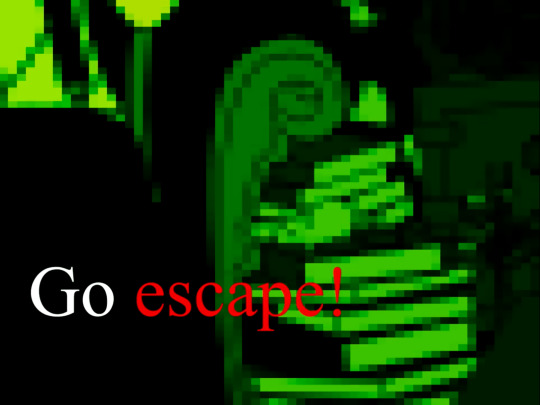
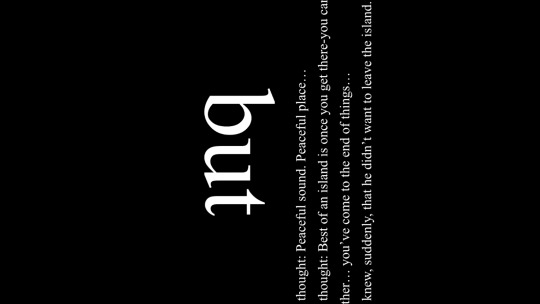

The text here reads: “If you’re Hythlodaeus, then I must be Morus.” This refers to the work “Utopia”, written by Thomas More. The book follows Raphael Hythlodaeus, a man who claims to be from Utopia, a perfect place for everyone. His surname quite literally means “Bringer of Nonsense,” or something along those lines. While this may be a stretch, I believe that “Hythlodaeus” is referring to Pre-Reveal David, and “Morus” could possibly be either Post-Reveal David or someone affected by his speeches, for example Xander.

Also, I find it interesting how the girl in this frame, most likely David’s “sister,” Diana, and David himself are both tilting their heads at similar angles. It’s possible that their relation is hinted at through this, but I’m not sure.
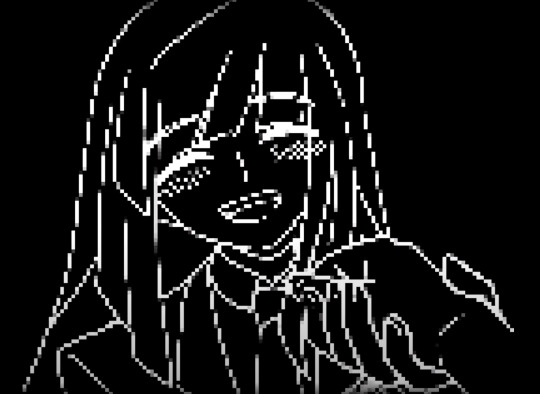
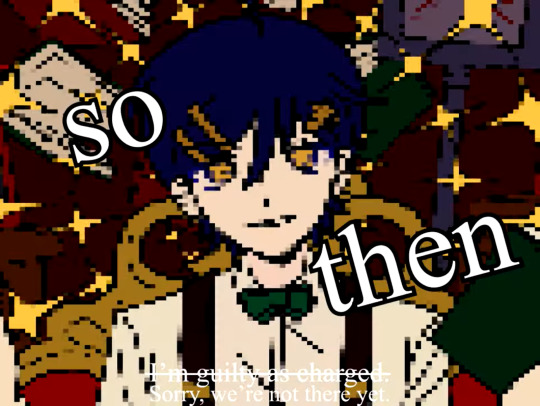
The excerpt right here is from Kajii Motojiro’s entry in the Kyoto Journal, entitled “Lemon”. While some of the text has been altered, the main story is about a man who finds himself suffering, and walks through his neighbourhood only to find a greengrocer selling lemons. He goes home, and finds himself happier than before. I’m not sure what this means when it comes to David, however if you’d like, you can analyze for yourself and let me know.
https://www.kyotojournal.org/fiction-poetry/lemon/

This part doesn’t have any external references, but I believe that the lyrics here reinforce David’s worldview, that no matter what you do and how hard you try, “nobody ever changes.”
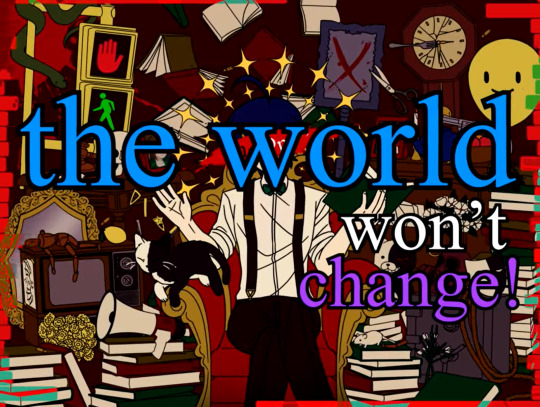
The star imagery here is a direct reference to David. Stars are representative of his happy facade, and when he loses the stars, he quits the bullshit.
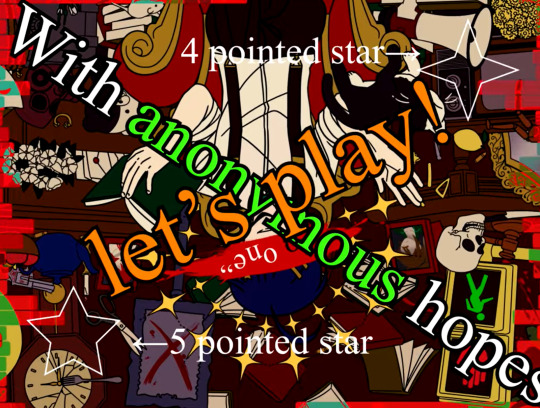
…And this frame. Alright, let’s start from the top. The electrocution definition is a callback to Xander, who’s referenced quite a few times in the video. The yellow text, which is from Antoine de Saint-Exupéry’s “The Little Prince”, is possibly a reference to David’s view on other people or himself- That nobody is special unless you were born special. However, the end of the text describes that if the boy were to tame the fox, the speaker, that they would need each other. I’m not sure if this is a description of manipulation, or a codependent relationship, but the David parallels are there. That, and the title of a “little prince” probably refers to David and how he’s idolized by many. The green text is, again, from “The Flowers of Buffoonery.” The full text is as follows. “A man crushed by reality puts on a show of endurance. If that's beyond your comprehension, dear reader, then you and I will never understand each other. Life's a farce, so we might as well make it a good one. But real life is a realm that I may never reach. The best that I can hope for is to loiter in the memory of these four days, so steeped with empathy. Four days that count more than
five or ten years of my life. Four days that count more than a lifetime.”
In reference to David, this is more representative of his true feelings. Not the asshole persona or the facade, but the genuine feelings he has. He already feels far too gone by his own standards, and constantly puts on a “show” for other people in the form of his speeches.
The red text is possibly a person dealing with depression speaking on one of their symptoms. There’s no way I could find a source for such a short quote. A common symptom of depression is losing interest in things you previously found enjoyable.
The white text on the side describes someone who finds pleasure in solitude as opposed to being bossed around by other people. It’s a reference to David’s backstory, as someone who was pressured into putting on a performance for others, finding comfort in being alone rather than having to play pretend whenever around other people.
The white text at the bottom is a continuation of the white text at the top.
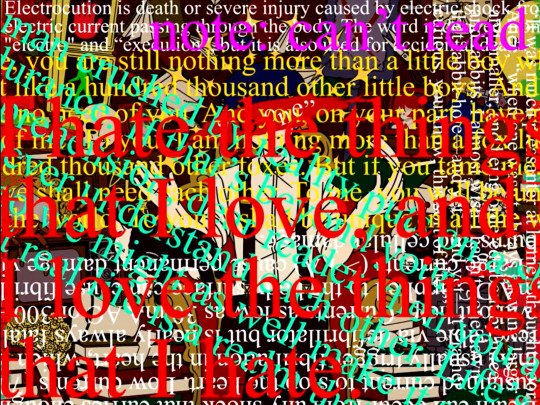
The only theory I can think of for this is that it’s a foreshadowing to either gaps in their memory or the amount of survivors left in the killing game being four. Not sure.
Update: I don’t know how I missed this, but the “11” next to the suspicious gaps refers to this. It’s possible that the suspicious gaps are gaps in their memory now, being as he doesn’t remember having an older sister, but her existence is most likely confirmed, as we saw her.
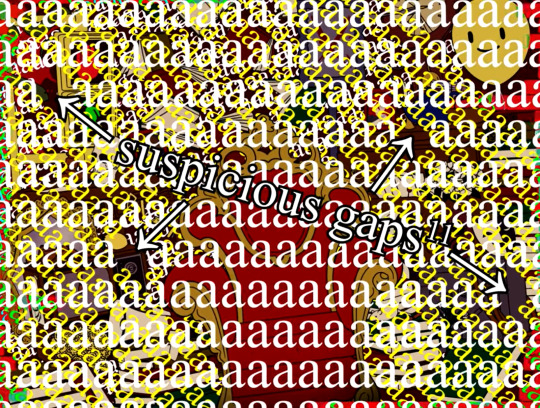

This part here is referring to “Catch 22,” when the main character realizes that without a soul, humans are just… matter, if you will. Empty husks.
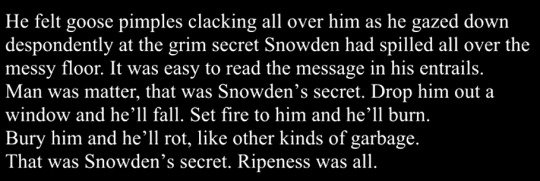
For this part, I had to call upon my not-so-trustworthy old friend, Google Translate! The translation of this from Latin is “I think, therefore I am (not.)” That’s what makes the most sense to me. We’ll refer back to this part later, for I have a different intention for it in my mind than David himself.
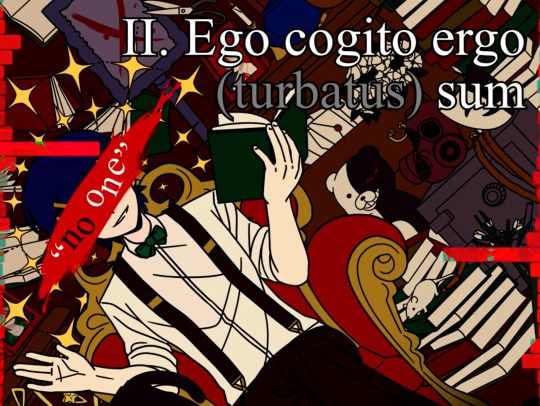
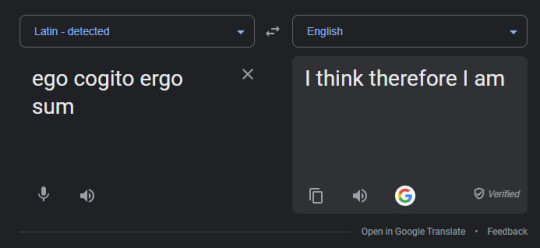
The dark blue text is another excerpt from “The Little Prince.” The prince in question is talking to a castaway, and the main takeaway of his words is that only your heart can tell you what you really need. If you were to simply look with your eyes, then what you truly need would be drowned out by the blinding light of superficial desires. I’m pretty sure that’s what that means. David is looking through his eyes, seeing a cruel world where nobody changes unless they were born to.
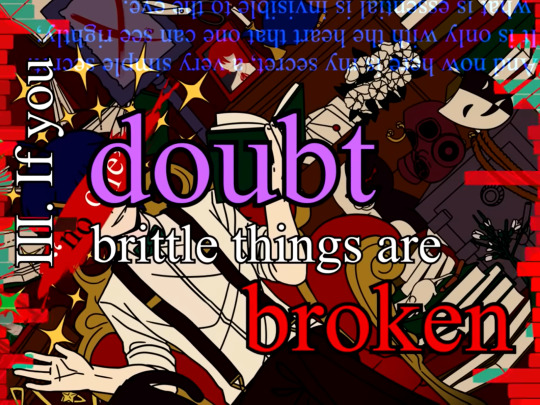
Now, let’s get into the next big part of the MV: The crossword puzzle. You might be wondering how this relates to David, but its moreso his own commentary on his classmates. Let’s go back to the latin. Pay attention to this reference of the solved crossword by raspbeyes on Tumblr. It will be very important for you to follow along.

Notice how there’s roman numerals in some of David’s lyrics? For example, this that we established earlier meant “I think therefore I am (not.)” This is referring to Rose. Her photographic memory can be linked to the description of “thinking.” The context of this may become clearer in future parts of the story.

III. That’s Charles. “If you doubt brittle things are broken.” Is, in my mind, referring to his memories. He has a recurring element of not remembering things, but he doesn’t seem to be aware of this until Chapter 2. For example, his secret- “Your older brother died, but you don’t remember him at all.”

IV. Arei. Her breakdown sequence should be all you need to associate this with her.
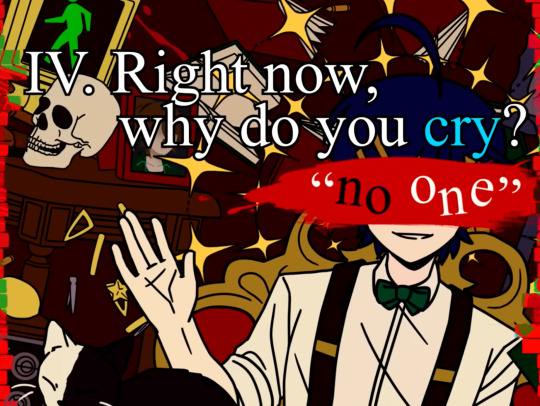
V. This is Ace. He’s going insane, obviously, because of the paranoia and failed murder attempt against him. That, and he’s become more disheveled as the game progressed.

XIV. Veronika, correct? Substance to the arts relates to her talent as a Horror Fanatic. Naturally, she’d be related to things like that.

XV. Whit’s refusal to accept his mother’s death, staying ignorant to the tragedies around him, is one of the “happiest” members of the cast.


XI. Mai Akasaki is not mentioned in the current story, and all of her quotes hidden amongst the cast members describe her in past tense. She was someone everyone viewed as reliable, trustworthy, and perhaps, if you exaggerated it, as God.
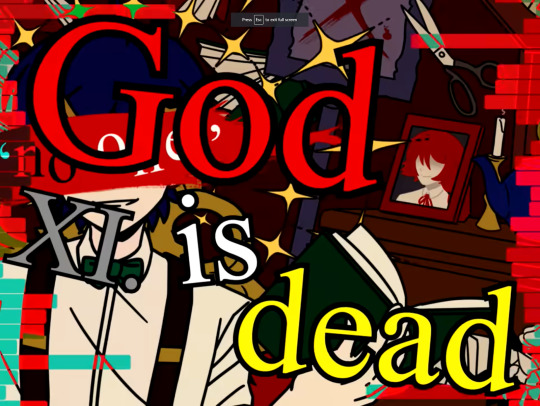
These two walls of text are both from the same source: Hamlet’s Solliloquy of “To Be, or Not to Be?”

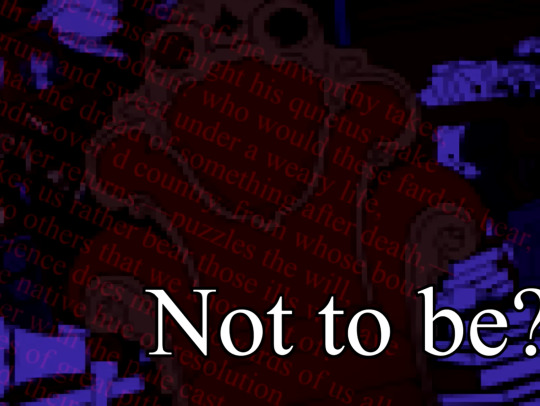
This is what the thing actually means, in case you aren’t aware, which even I wasn’t until just now. It represents David’s suicidal ideology, from what we can assume with the way he’s trying to get everyone to vote wrong in the trial for Arei, quite well. Whether he wants to live, or die, is most likely a constant struggle for David to answer.

Which is why he leaves it up to… whoever can answer.


This is an absolute reference to the trial. The class trial rules are overlaid over the death portrait texture, which is “conveniently” covering David’s face. The seventeen here is also telling, considering what the description has to say about it!
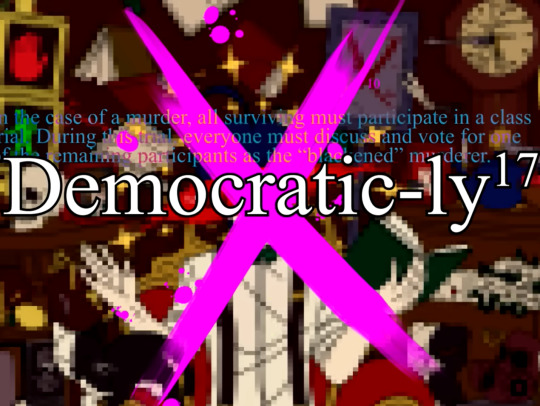

This is what I believe is David’s end goal. To get everyone executed as a result of his own hopelessness. By pretending to be the killer and antagonizing the class, he believes he can easily sway the votes by “manipulating the public” as he always believes he’s done. By getting everyone to vote for him, he can end the killing game and his own “pathetic life” in one fell swoop.
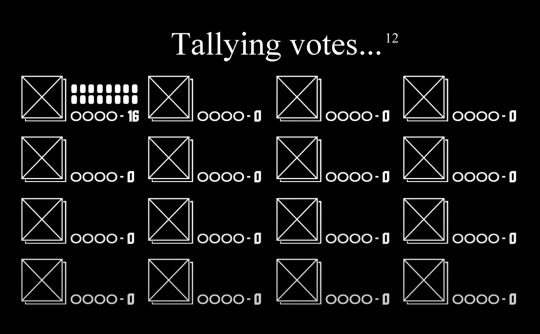
After all, it’s not like he believes they have a chance of winning and escaping in the first place.
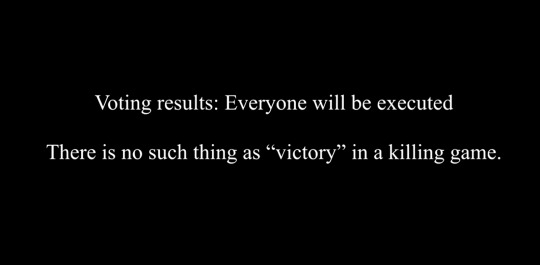
And here, is where we left off in Episode 11. David completely drops his facade in order to effectively kill himself, along with everyone else. After realizing the hopelessness of his situation, he makes a drastic turn to accept it readily. Someone who self-sabotages continues to do so because they develop a warped perspective of having control.

And again referring to the description, the 12 near the “Tallying Votes” caption refers to this. It’s David’s way of justifying his selfishness, with a diluted form of justice serving as an “ultimately fair verdict to the trial.”

However, David has always wanted to be loved. It’s why he even bothers with his facade, because he’s been putting it up for so long that disregarding his persona would effectively ruin everything he’s worked so hard to maintain in the first place. The repeated imagery of applause could also be a callback to his status as a celebrity, especially with how he reacted to Xander and Arei’s reliance on him.
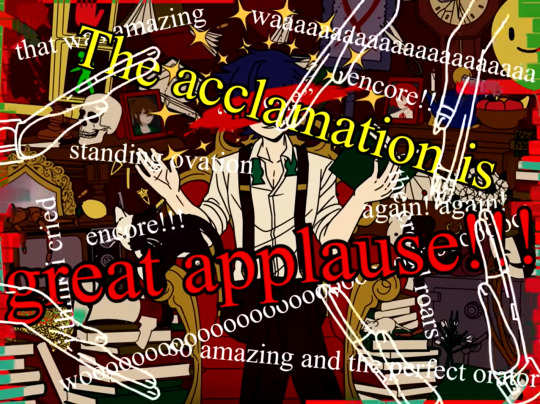
While this does have a small fade of text pointing out that the “degraded copy” is the cover, which is not true because the MV is amazing, but. I believe this–

Oh. That’s literally it. Well, that makes one mystery solved!

Hey, look, we’re already halfway through! nice! Eden’s optimistic personality can be referenced here. She wants to live with everyone, together, and make sure that nobody gets hurt.
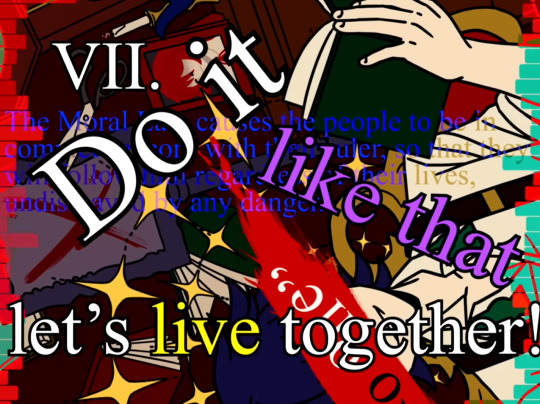
This is another reference to David’s rambling on about how attempting to change is utterly futile, and that nobody changes.

The yellow text is the definition of a television show, I believe. The blue text is an excerpt from “And Then There Were None,” by Agatha Christie. The full quote is this: “Breakfast was a curious meal. Everyone was very polite…. Six people, all outwardly self-possessed and normal. And within? Thoughts that ran round in a circle like squirrels in a cage…. ‘What next? What next? Who? Which?’...” …Do you get it? It’s a parallel to the killing game. Or, rather, how David views it. Everyone is terrified and scared for their lives, but they still greet eachother with mock kindness.
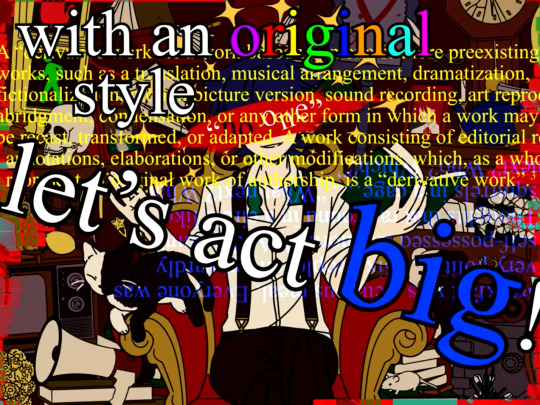
The blue text on the side is an excerpt from Shakespeare’s “Macbeth.”, and it goes like this: “I am in blood / Stepped in so far, that, should I wade no more, / Returning were as tedious as go o'er.” A critical analysis of the original work reads as follows: Shakespeare is saying here that Macbeth has involved himself in so many murders that it is as easy for him to carry on than to turn back. Macbeth compares his course of action with wading across a river of blood, creating a vivid image of his bloody reign. The word 'tedious' reveals the hardening of Macbeth's heart.

And now, the moment I’m sure most of you have been waiting for. Xander. Something I took notice of was that the cracks line up directly with his left eye, while his right eye is the one that’s actually missing in the game. Nonetheless, Xander clearly did mean something to David. Whether it be through his idolization of David, or if he inspired David in some way, his death had an impact on him. Manipulative persona or not.
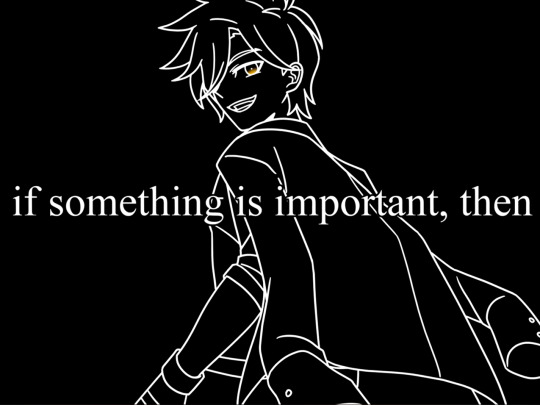
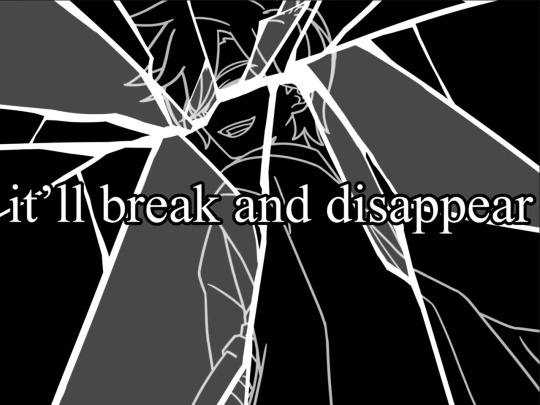
XVI translates to Hu from the crossword puzzle. He’s taunting her, similarly to how he did in the trial, although the ??? makes me wonder if it actually IS David…

XII, that’s Eden. I assume it’s because of her optimistic persona that she is standing in someone’s way, although we’re not sure who.

For the next part, let’s say we take this at face value. It could definitely be referencing David allegedly pushing Arei to commit suicide, although this could also be something he internalizes, with the themes of suicide and wishing to be dead explored previously.
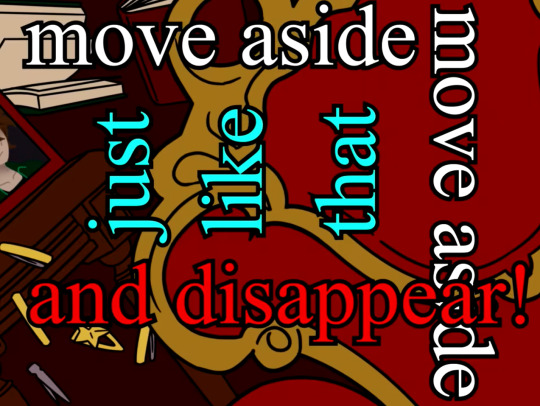
These are all repeats of the previous works included in the MV, like The Little Prince, Ozamu Dazai’s series, Agatha Christie’s works, etc etc.
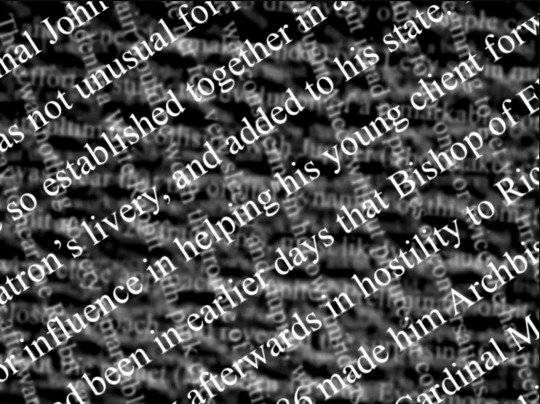
Now, this is code, I’m assuming, but I tried translating it and couldn’t find anything. It’s a common encryption language. In case you want to translate it, it’s: 3aqxw97pktc8uki458fbdpfoacllex2f07bf8mg24b4mpfx2adc6v3f5yhxjd8i7sf11312zaj5lazet47jod5jczec5mvb6bz2o59r143sf2pe916sczcn7emvbl55ehe9iqb2708tt83482c8tw3c77gn47ojca634gbcfz0016s647wwlakcn46brcle0eam9
NOTE: @glorywelpchild on Twitter says… “For this, it may have been encrypted multiple times by different engines? I'm not a programmer so I'm not really familiar lmao. Another thing, it could be a type of programming the dev knows/commonly uses.”
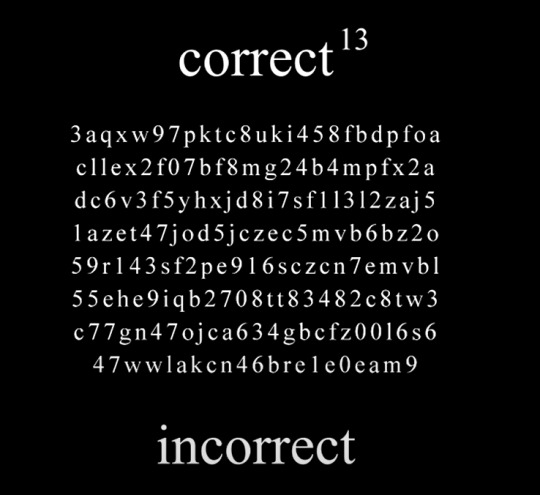
The VI here is Arturo, but I don’t know what this means. Perhaps the description can give us some insight?
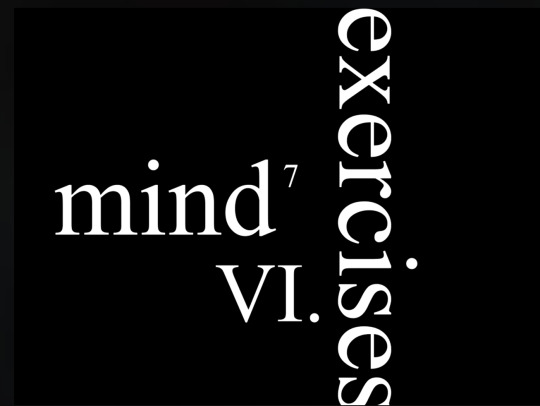
Hmm… Well, I don’t mind. Whatever you say.

Nico’s number is VIII, and this is referring to the defense they put up when asked about their intentions against Ace’s life. They claim they never thought about it, and “even if they try to think, they don’t know.”

This is Levi’s, as per the IX.
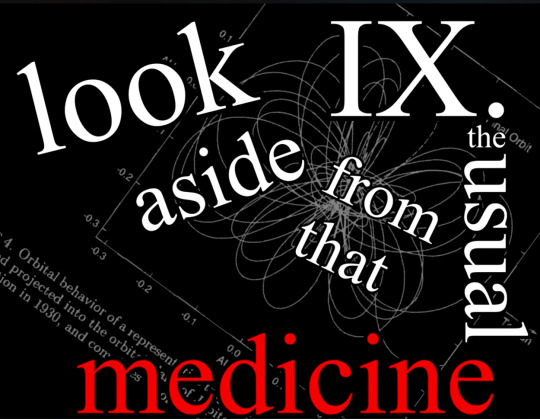
I actually managed to find the original image in the background. It’s a study on Comet Shoemaker-Levy 9’s orbit around Jupiter for several years before crashing into the planet. While the name, Shoemaker Levy, may be a play on Levi’s name, I believe this is also referencing that he may die soon. Maybe this is a stretch, but the symbolism of a comet named “Shoemaker Levy” crashing into Jupiter being right under a symbol that represents Levi, our prime suspect in a game where being caught results in death, is too far to be a coincidence. Part of my theory for Chapter 2 is that Levi is the blackened, after all, but that is in a previous post. Nonetheless, we can move on.

This is “Enterance of the Gladiators.” While it is now associated with silly things like clowns, it was originally a military march song. Hmm, where have I heard this description before?
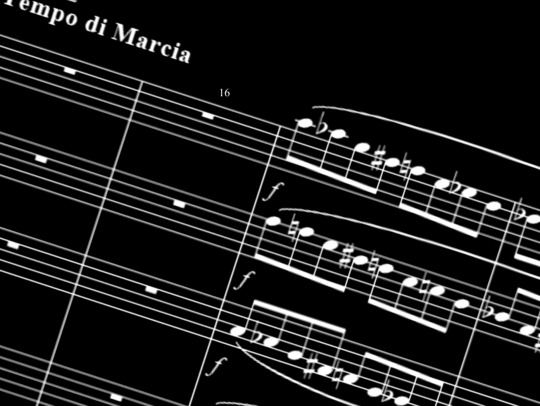
Ah, that’s right! In the description!

These two are relatively straightforward. The David we meet in the prologue is his facade, and it serves as an introduction. However, we are re-introduced to him with a whole personality change, and that comes delayed from all the others.
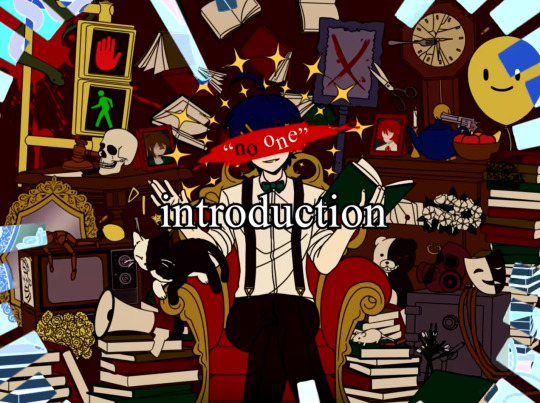

This is a direct reference to MonoTV and the throne in the trial room.

The truth bullets. Typical Danganronpa symbolism, and it’s also a neat little reference to Xander’s custom weapon.
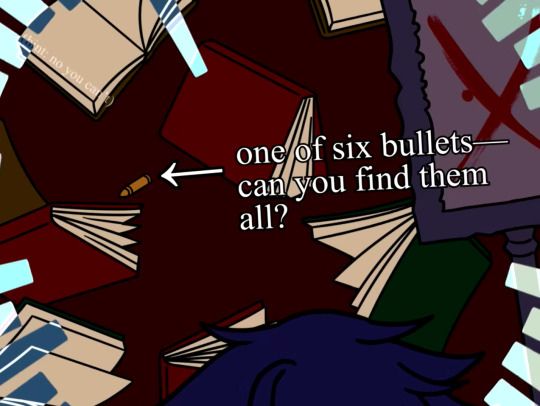
References to some of the students. The dresser is Levi, the bowl of fruit is Rose, the gun is Xander, the teapot is Hu, and the candle is maybe J?
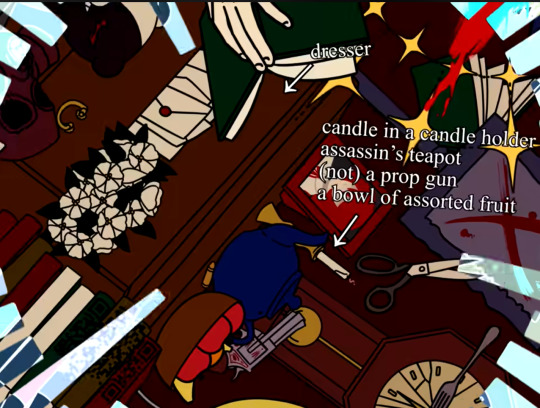
The clock is Eden, the portrait, maybe a reference to the game? The stupid kid’s toy might be Whit.
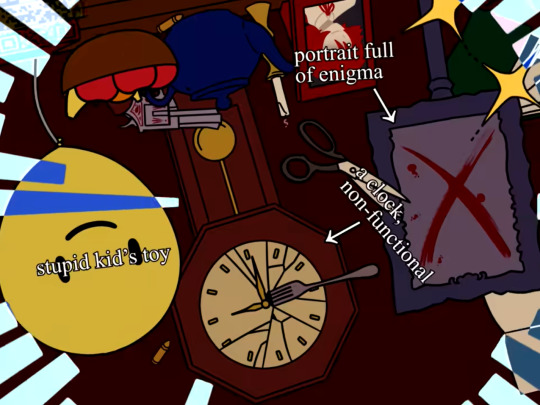
Teruko and Mai. Teruko’s misfortune and Mai’s idealization are both key parts of their characters.
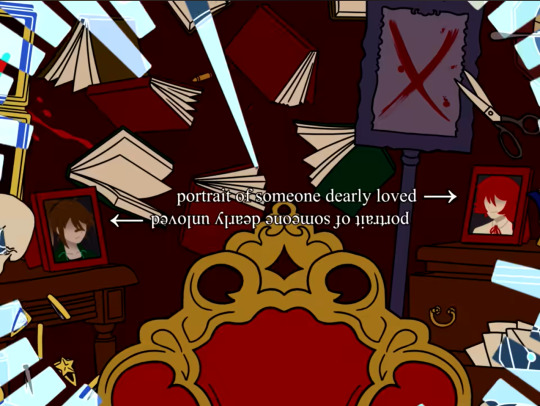
The gavel, another reference. The kitchen knife, Min. The skull, Veronika. The mirror… Possibly Xander because we’ve seen him with broken glass earlier in the MV, but it might be David and his personas making another reference.
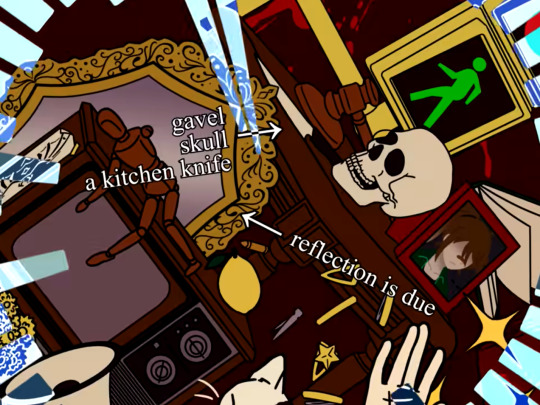
The mastermind, sitting atop their comfortable chair.

The noose is Arei, the gas mask is Charles, the mouse is Nico, the theater mask… Perhaps the mastermind again, or Veronika again. The safe is David’s locked away and suppressed emotions. These are all mainly theories based on observation, don’t take it as the wholehearted truth.
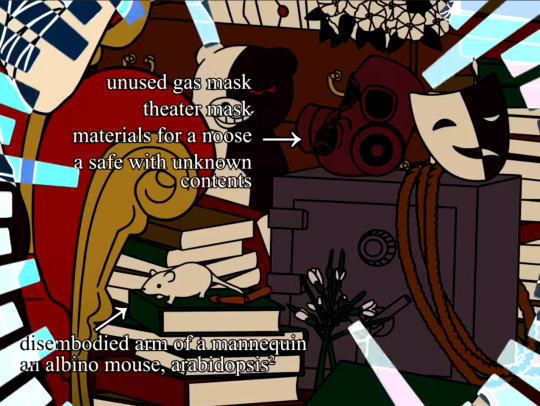
David being mentioned again with the hair clips. The lemon has been brought up beforehand, it’s a callback to the journal entry. The dummies represent David’s detachment from his humanity, and the television is a callback to the fact that they’re on a television show.

David views himself as a snake, a liar, a murderer. Snakes are common imagery to use when referring to the Devil as well. The blood is a callback to the killing game itself.
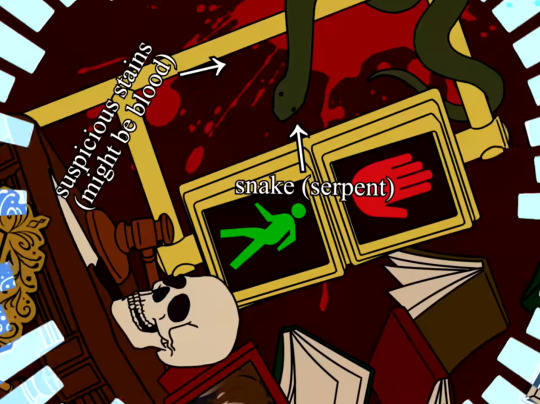
Either a reference to Min, or the fact that all the books are empty could be visual dramatization of David’s feelings. There’s supposed to be something in them, but the books are empty. The “various kinds” could also be how many personas he puts on, if that’s a prominent part of his backstory.
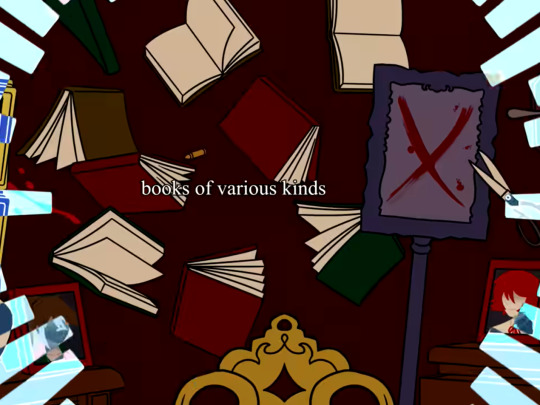
The killing game is being broadcasted, so that counts as terrorist iconography, if nothing else. Dandelions, while beautiful in their own way, don’t belong in a garden. The megaphone is David’s custom weapon, and it’s a way for him to broadcast his speeches to those around the world.
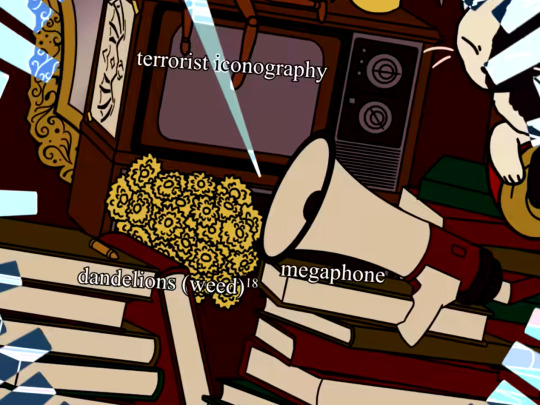
The letters are from the joke comic that the dev released. You know the one, where Xander writes a letter for David and he accidentally throws it away thinking that it’s garbage. The popular toy refers to the commercializing of the Tragedy, as Veronika explained on the first day of Chapter 2. How horror movies will put black-and-white designs in their films to up the fear factor because of the subliminal/primal fear of the design back in the days of the Tragedy. The flowers… No idea.

This is cleverly disguised, but it’s a reference to the debate between continuing to live and killing yourself. To be or not to be, to stop or to keep going, but they’re both lit up. How are you to do both at the same time? You have to make a choice.

Main Roles are David and Xander. It makes sense, considering they both have full-body moments and we know who they are. The crossed out name is Mai Akasaki, but the cut off name is a bit harder to decipher. Thanks to some inspiration and help, I’ve come to my final conclusion regarding this.

They are related to Arei, 100%. The letters match perfectly.

Even in comparison to Arei, the “N” in her name starts only a bit earlier, but that’s because the first word is probably only two or three letters, in comparison to the four letters in Arei.
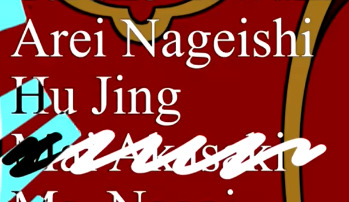
Originally, I couldn’t translate any of these. All I could make out was that the first hand was Xander and the second hand was Min or Mai. However. @MAHIRUMILGRAM on twitter managed to translate them! They are as follows:
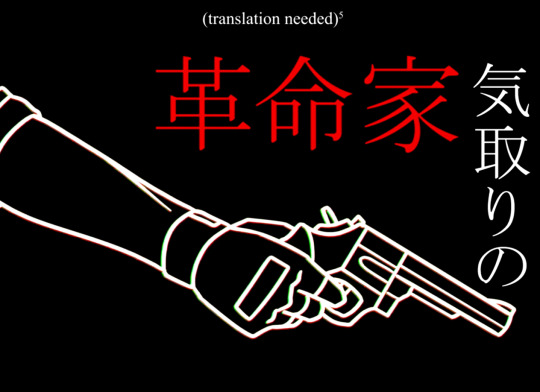
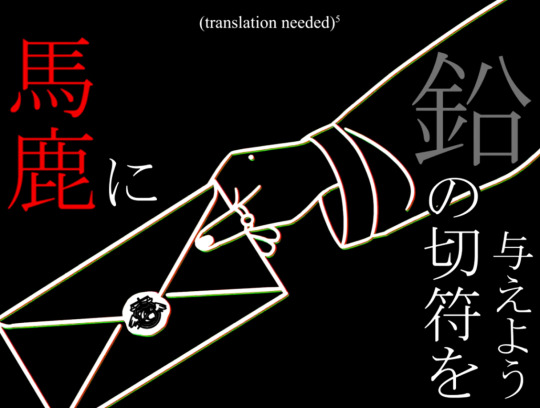

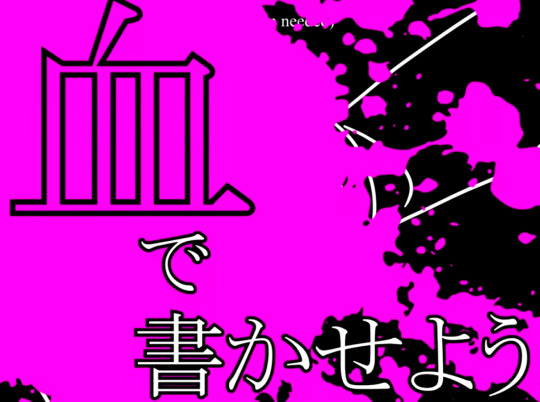

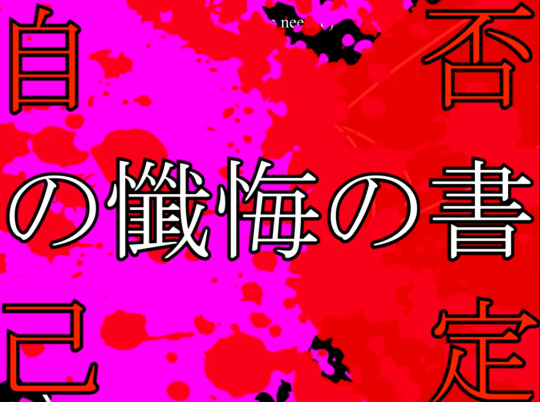



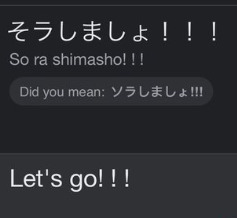
After this point, the truth bullet breaks through David’s words, similarly to how Teruko is fighting against David, despite the truth bullet being in agreement towards David’s idea.
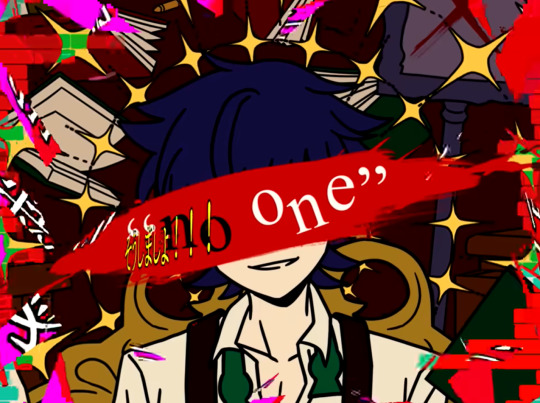
There’s also this, which could be David trying to deflect us from the truth, or that the lyrics genuinely don’t relate to him. I’m leaning towards the former.

The white text at the top here is from a story, entitled “The Ones Who Walk Away from Omelas.” It is about a beautiful city where everyone is happy. However, their city is not as beautiful as it seems. They tell the story of how the townspeople have locked a child in a basement, and left it to suffer. Their happiness, as they’ve been told, requires a sacrifice. “Inside the room, which is behind a locked door, there are a couple of dirty mops, a bucket, and a young child. The child is ten years old, but looks younger. The child is scared and completely miserable. It is never allowed to leave the room. Occasionally, someone opens the door and kicks the child to make it stand up. The person fills the food bowl halfway with corn meal and grease, fills the water jug, and leaves. The child can remember what the outside world looks like and begs and pleads to be let out. The child is naked and covered in sores, and it wails at night in its misery. The people of Omelas all know about the child in the basement. They all understand that everything good about Omelas, from their abundance of food to the good weather, depends upon the suffering of the child. They all understand this because when children are between the ages of eight and twelve, they are brought to see the child, and this tradeoff is explained to them. During this experience, the children of Omelas are disgusted. They want to help, but they are told they can’t. If anyone helps the child by clothing, feeding, or otherwise caring for it, then the perfect happiness of Omelas and its abundance would die. Therefore, no one may even speak kindly to the child.” I wanted to include this because it describes David so well. Someone who has been cast away because they’re deemed useless to society, someone who’s happiness would destroy the happiness of anyone else. I find the story truly fascinating, as it might describe David’s suppressed emotions and the depressive tendencies he indulges himself in.
“Their tears at the bitter injustice dry when they begin to perceive the terrible justice of reality, and to accept it. Yet it is their tears and anger, the trying of their generosity and the acceptance of their helplessness, which are perhaps the true source of the splendor of their lives. Theirs is no vapid, irresponsible happiness. They know that they, like the child, are not free.”
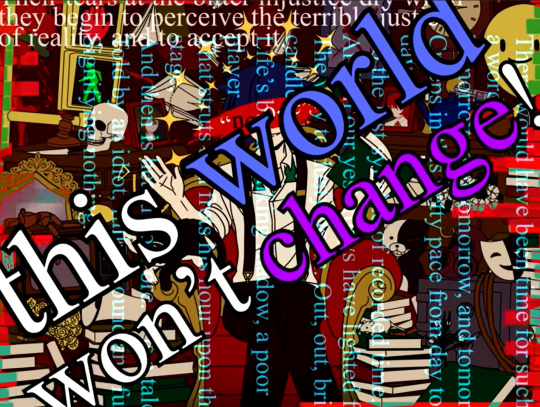
“How you have felt, O men of Athens, at hearing the speeches of my accusers, I cannot tell; but I know that their persuasive words almost made me forget who I was—such was the effect of them; and yet they have hardly spoken a word of truth [alēthēs]. But many as their falsehoods were, there was one of them which quite amazed me—I mean when they told you to be upon your guard, and not to let yourselves be deceived by the force of my eloquence. They ought to have been ashamed of saying this, because they were sure to be detected as soon as I opened my lips and displayed my deficiency; they certainly did appear to be most shameless in saying this, unless by the force of eloquence they mean the force of truth [alēthēs]; for then I do indeed admit that I am eloquent. But in how different a way from theirs! Well, as I was saying, they have hardly uttered a word, or not more than a word, of truth [alēthēs]; but you shall hear from me the whole truth [alēthēs]: not, however, delivered after their manner, in a set oration duly ornamented with words and phrases.”
Do you remember, in the prologue, where Xander describes the “rumors” against David’s positive front? This is a direct parallel. Here, Socrates denounces the words of his attackers, similarly to how nobody truly believes the rumors except for the critics themselves. Even Xander was fooled by his charisma.
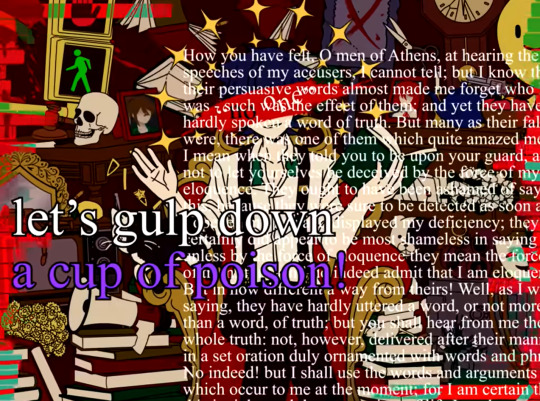
“Was't Hamlet wrong'd Laertes? Never Hamlet: If Hamlet from himself be ta'en away, And when he's not himself does wrong Laertes, 240 Then Hamlet does it not, Hamlet denies it. Who does it, then? His madness: if't be so, Hamlet is of the faction that is wrong'd; His madness is poor Hamlet's enemy.”
Hamlet blames his own insanity for the death of Laertes’ father. Just like David tries to get everyone killed, and blames himself for murdering Arei, because of his own insanity.
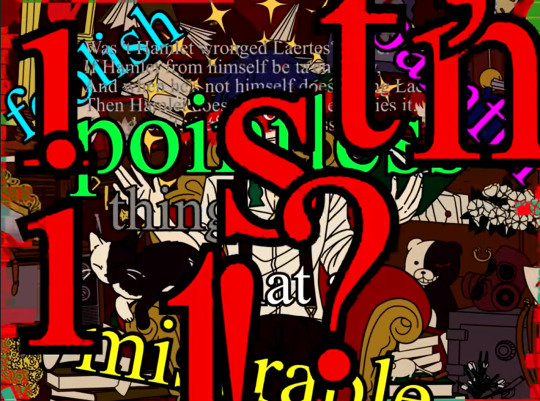
This is a line from the poem “Be Not Defeated by The Rain,” by Kenji Miyazawa. It describes a man wishing to become someone strong, someone who cannot be bested. I believe this is exactly what David wants, too. To be as strong and as hopeful as he is forced to pretend to be, instead of a hopeless mess who would rather die than be seen as worthless.

David reaches the height of his insanity, before finally quieting down after being basked in green light. I don’t know if this was intentional, but I believe that it represents how he’s given up on even death after the students manage to vote correctly, hence the green coloring.

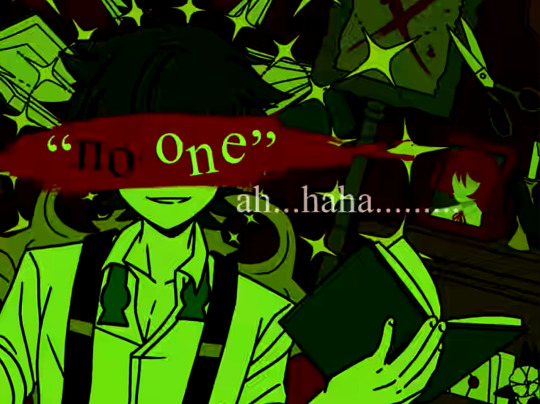
And now, number 19.
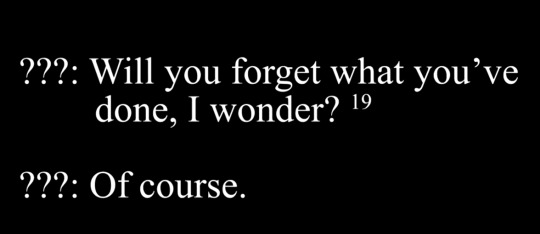
I severely doubt that David will actually die in Chapter 3. That is not “foreshadowing,” that is just giving out the answer, and DRDTDev is much more careful than that. I believe this is a final representation of David’s suicidal ideologies. He says he will forget, he says guilt will not weigh him down, but he’s lying to himself. That’s why the stars are still behind him, because he’s still lying. He says he is satisfied, he says he’s okay with death, but when has David ever been truthful with us?
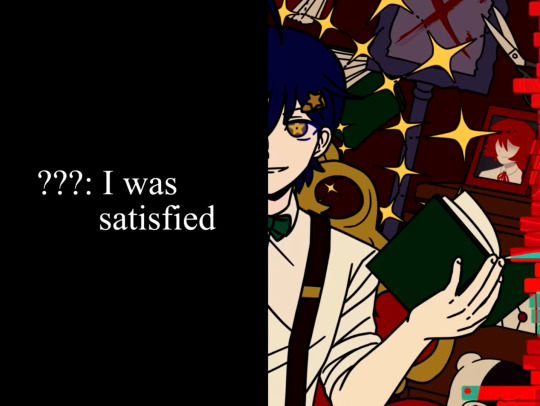
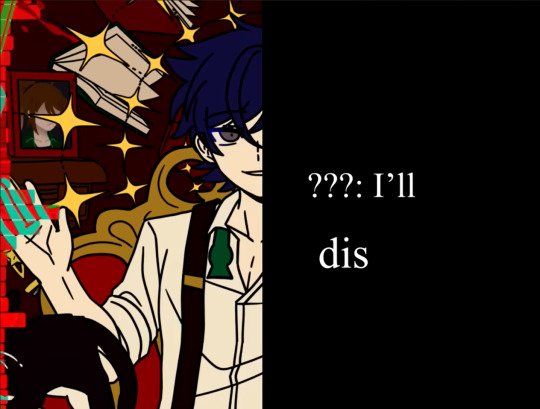

And he leaves an empty throne behind. Not because he is dead, but because he has relinquished his career and his reputation for nothing.
Even though he is missing, nothing else has changed. That is how he views his life.

And that concludes the main analysis of David’s MV! It’s such a beautiful thing, really, I don’t know how to phrase any of it properly. Thank you to everyone who’s read this far, and everyone who helped me out. The decoding and puzzles? Ah, I’ll let you all do that… But, maybe I can help a little! Blanket, out~! See you all next time!
#danganronpa despair time#david chiem#dr#mv analysis#WOOH THAT TOOK ME 6 HOURS.#levi fontana#nico hakobyan#mai akasaki#ace markey#veronika grebenshchikova#eden tobisa#teruko tawaki#hu jing#arei nageishi#whit young#charles cuevas#rose lacroix
164 notes
·
View notes
Text
MESMERIZER ANALYSIS!
Hi guys, Aurae is back at it again at Krispy Kreme, this time with a voacloid song analysis (woah!). So, before we get into this, here's my usual disclaimer! I have been researching psychology for a WHILE and I plan to go into it professionally (:O). HOWEVER, that said, I am NOT a professional, so understand that everything I come to conclusions about has been analyzed with some personal judgement, personal interpretations, and this is just what I have concluded.
This also contains a lot of personal projecting onto this song as art is aways up to interpretations, and I see a lot of my childhood in this song. I will be touching on topics that are implied through lyrics, and you may not see this song the same way that I do, and that is perfectly okay! This is my take on deconstructing some of the messages that this song has.
A TW FOR THIS ANALYSIS INCLUDES: hypnotism, escapism, unhealthy coping mechanisms, suicide, self-harm, depictions of abusive environments (as that is how I interpret this song), manipulation, gaslighting, dehumanization, neon colours.
So, now let's get into the confetti and fun wonderland of MESMERIZER!
I'll be splitting this into three parts: The part where I talk about the song lyrics, the part where I talk about the animation itself, and then I'll explain a few theories I've seen, as well as my own, adding onto the story that I think it is telling.
PART 1: SONG LYRICS ANALYSIS
“No thinking about real feelings
Are you pretending to not notice?
The absolute truths and your own heart
That's how the safe zone is shrinking
Prostituting your wounds
You give a feeble cry, such shameful conduct”
Although the song itself is quite catchy, cheerful, and jubilant, the lyrics are far from those things. We immediately start off with the idea of disregarding one’s own feelings, Miku talking about how people pretend not to not notice their own feelings and the ‘truths’ of their own hearts. However, this is hard to avoid forever, and their ‘safe zones’ (escapism places) are shrinking as reality creeps up on them, so they ‘showcase’ their sorrow to others. I think this is definitely a metaphor for how some people overshare to others and tell others all about the ways that they’ve hurt, which can be used against them, as this gives others easy access to material that could be used to manipulate them. However, there are also undertones of self-shame (which comes with trauma), calling their cries for help ‘shameful’. It should also be noted that some abuse survivors, while being abused, have relatively clear cries for help through their actions that nobody else seems to pick up on, which is also a theme in this song as nobody answers Teto’s cries for help.
“I’ve got a recommendation for you, the ultimate escape
Eventually, you will be saved from being lured into sweet traps
Now that you can no longer live sanely in this world anymore
Perhaps pretending to know nothing
And surrendering yourself is the optimal solution”
This ‘ultimate escape’ that the song talks about is escapism, or imagination. Reality is too hard to deal with, so children turn to their own minds as a way to stop the pain from taking over. It’s much easier to live in a dreamworld rather than a reality where you’re being hurt, right? They say that ‘ignorance is bliss’, and they’re taking it to the next level here by repressing, ignoring, and denying their own true feelings in order to feel happiness. They escape to that ‘safe zone’ mentioned earlier within their minds. However, there is an irony in the second line where they talk about ‘sweet traps’, as it can be interpreted as the imaginary world being ‘sweet traps’, or maybe the harshness and certainty of reality can be considered a ‘sweet trap’ as well, depending on how you look at it.
“If a bunch of flowers dressed up with words
Can steal one's heart, are they real?
To an event where everything will be tainted
I give you an invitation”
This runs even further with the idea of imagination and escapism, because flowers cannot literally dress up and speak in the real world. This is talking about how maybe the characters feel like they can no longer distinguish fiction from reality, talking about how fictional things can make you feel things, so they must be real, too. It’s basically saying that because fiction has such an effect on us, then can fiction and imagination be considered to be another form of reality, as well? However, it is mentioned that the event will be ‘tainted’, possibly referencing the idea of fiction completely overtaking reality.
“Farewell
You're tailor-made for this era
With an appearance of vulnerability
Fooled by this truthful acting
Your heart beats so very loudly
Your extra lives are quickly being lost
Your durability worn away
Dodging matters right in front of you
You got your hands full just living”
This is where we go back to the idea of manipulation, and maybe even conditioning. ‘Tailor-made for this era’ implies that something turned these people into the kinds of people that would be easily manipulated. It is also implied that the two are hurting and explicitly stated that they’re vulnerable and easy to take advantage of. I would consider the theme of hypnosis and brainwashing to tie into this as well. They are more vulnerable to the idea of being manipulated and taken control of due to the fact that they are hurting and want to escape to another reality, and will believe anybody that says that they will make things better because they are hurt too much. They are fooled by the acting of the people that pretend to love them, who are really here to just control them. This is talking about the urge that people have to run away from reality, because just getting up and existing can be such a challenge.
“You’re getting sleepy, a shallow hypnosis
Your head, your body are becoming muddled
No way, so many tricks?
Swinging a coin before your eyes
You'll become completely still
"This is fine," even you can be coaxed into shut down”
This is Miku’s part, and the part where she is completely hypnotized and taken control of. She ‘shuts down’, completely rejecting reality and going into the ‘imagination world’. She does not want to feel pain any longer and takes the opportunity to run from it, turning into a puppet for others to control and manipulate.
“You're getting sleepy, a shallow hypnosis
Your head, your body are becoming muddled
No way, so many tricks?
Swinging a coin before your eyes
You'll become completely still
(coercion cancellation)”
Teto’s part however, in the middle of it, fades out, as she does not completely listen to what the people have to say. She resists the manipulation, and it’s explicitly stated with the part where it goes ‘coercion cancellation’. She is actively fighting the urge to run away into escapism, and resisting the manipulation of whatever is trying to do so to them.
“However you survive today, it's unrewarding everyday
You're already in a bot-like cycle
Continuing from the moment of inertia
If you have no luck, no hope, it's all the more pointless
If you haven't got it then give up
Playing with the leftovers is your fate”
This is just more stuff about giving up on the real world. Inertia means “the inherent property of a body that makes it oppose any force that would cause a change in its motion”, aka: refusing to move, even when force is put upon something. I would say ‘inertia’ is a synonym for birth or consciousness, because it’s talking about how even from the moment that you are born that you are stuck in a cycle of endless pain in reality. This part is basically talking about why you should give up on reality entirely and simply live in the worlds of your own creation, running away into escapism and disregarding the real world in favor of not feeling pain.
“You’re tailor-made for this era
With an appearance of vulnerability
Fooled by this truthful acting
Your heart beats so very loudly
Exaltation has already lost its meaning
A fake charisma
If you stare directly at reality, you’ll end up going blind
So do it in moderation”
Once again, talks about being perfect subjects of manipulation. However, Teto speaks of the fact that the rush of joy that you usually get after originally going into the escapism world has already been lost, and that it is fake. However, she also mentions that if you keep on living in the real world the entire time, it will not do you any good, so she advises everyone else to live in your imagination only sometimes, but to keep an eye on the real world.
PART 2: THE ANIMATION
This is just a lot of things that I have noticed other people saying, but some tidbits about the animation include:
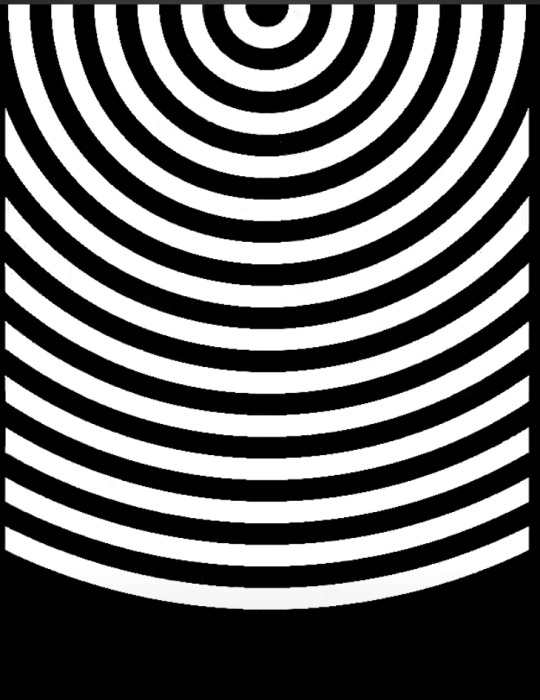
This is a screenshot from the very start, showing how there are themes of hypnosis from the beginning.
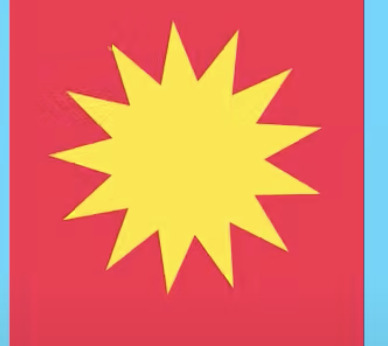
I believe it is also mentioned that the 13-pointed star that is shown a lot represents immortality.
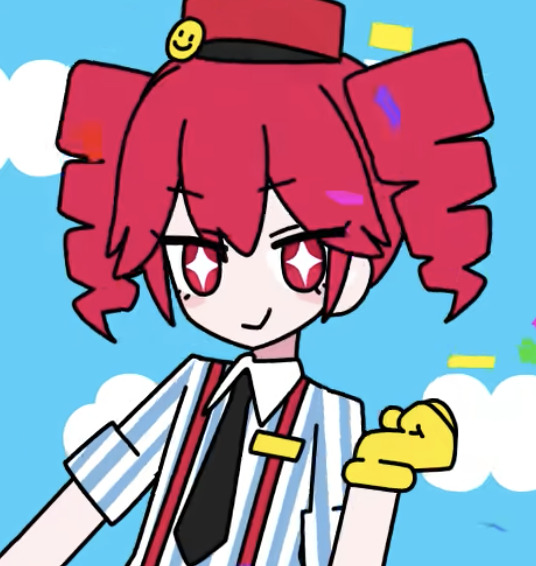
Also, can I mention that their outfits seem almost childish in nature? I believe that this is meant to represent that they are ‘vulnerable’, intensifying the idea that they are easily taken advantage of. However, these also look like worker outfits in the way, with the yellow rectangles almost looking like name tags. It almost seems like they’re workers for a children’s amusement park? Which would make the horror aspect of this even worse…
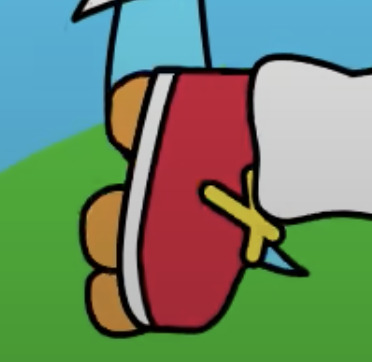
Miku’s shoes are rollerblades, which can be interpreted of her being more carefree and more willing to run away, because wheels are faster, and can also be interpreted of her being less connected to the ground/reality. It can also be shown in the idea that she is the more ‘childish’ of the two of them, being easier to manipulate, which is why she falls to hypnosis first.
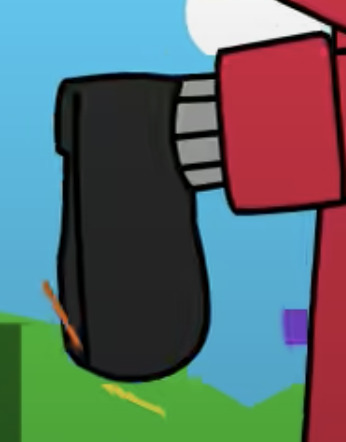
In contrast, Teto’s shoes look rather normal. Probably a representation of her being more grounded?
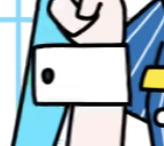
I’ve seen people interpret Miku’s cuffs as like places for strings to hold onto during her later animations, which can tie into her being more of a puppet rather than a human?
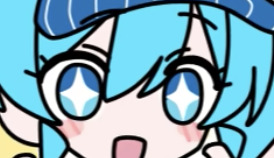
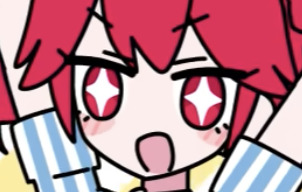
Star pupils at the start for both of them when Teto talks about an escape. They are clearly both looking for one.
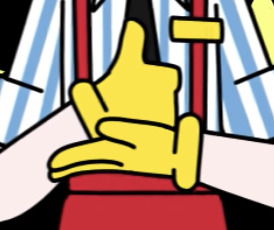
However, Teto pretty early on also does the ASL sign for “HELP”.
Also, Teto blinks in morse code for “SOS” during the first chorus.
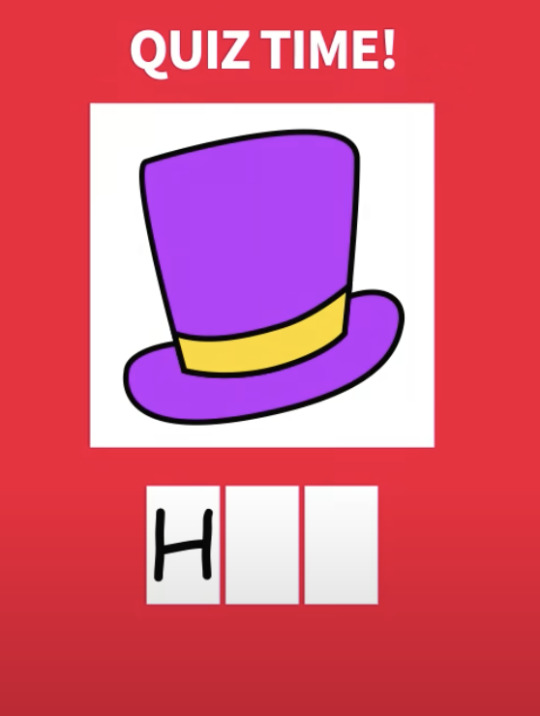
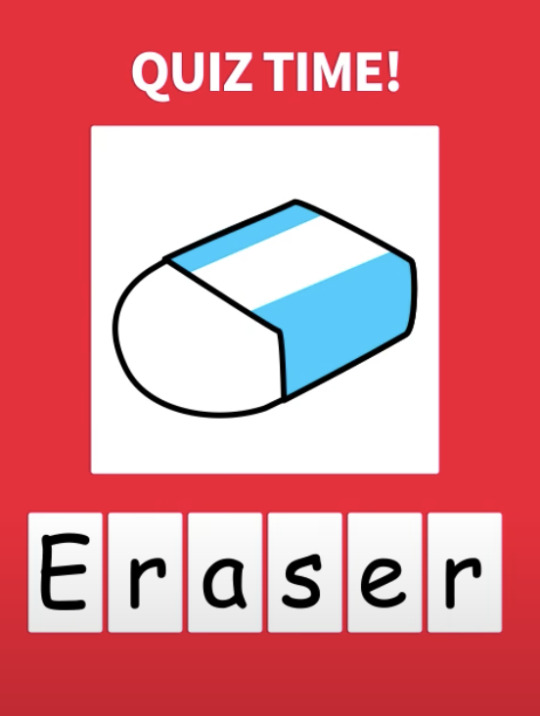
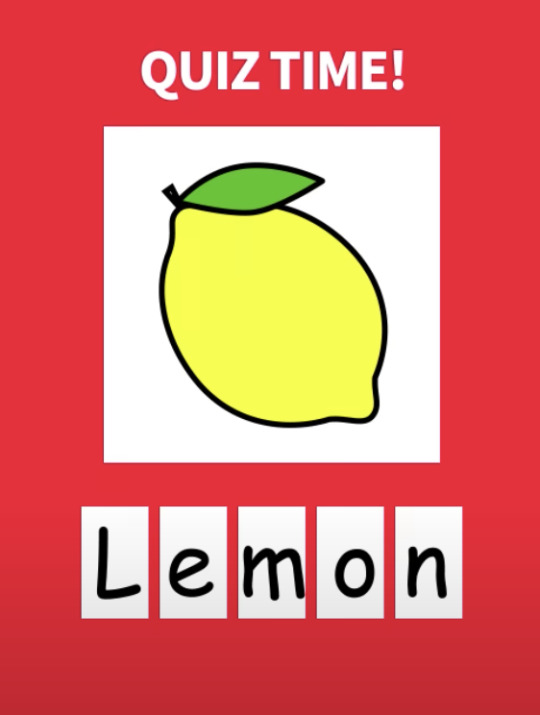
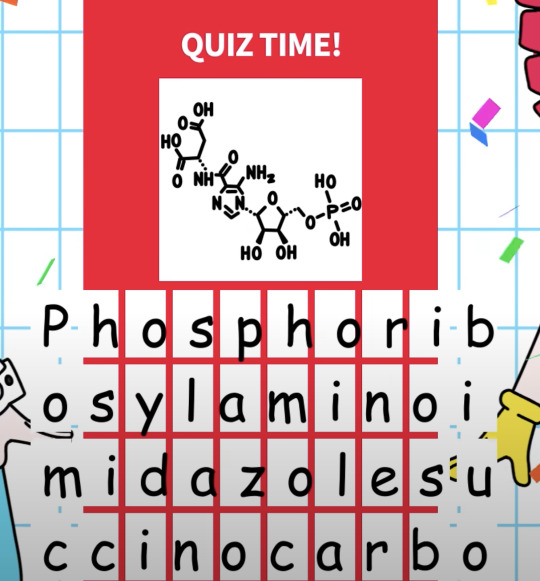
The first letter of all of these spell out “help”, while the fourth letters spell out “SOS”.
“phosphoribosylaminoimidazole succinic carboxamide” is something that helps with energy metabolism, as well as DNA synthesis. I believe this can be a reference to the fact that many abuse survivors go through dehumanization, or it could be a reference to the idea that neither of them feel “real” or “human”.
Also, at the end here, Teto makes another nonverbal sign for help with her hands.
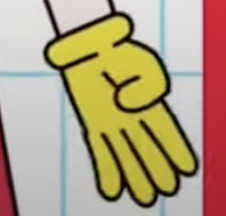
Miku is hypnotized pretty easily, swaying from side to side like following the motions of a coin.
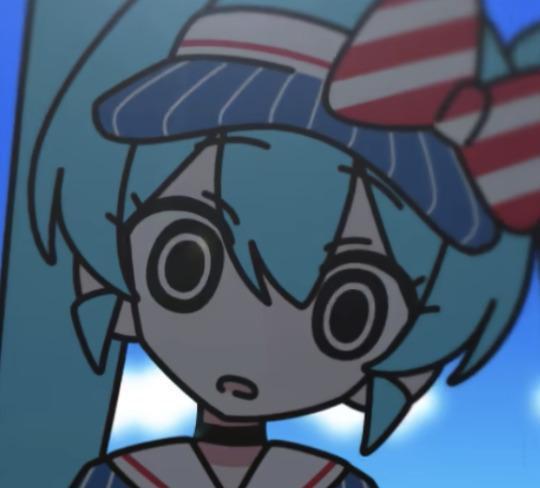
However...
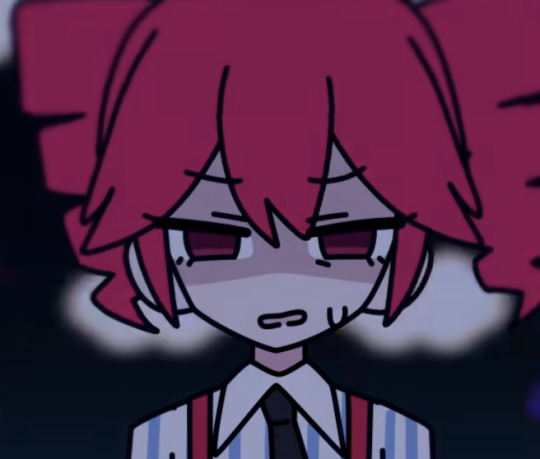
Teto resists hypnosis for ten days, if you count the amount of times the sun rises and sets in this scene. Although, at the end…
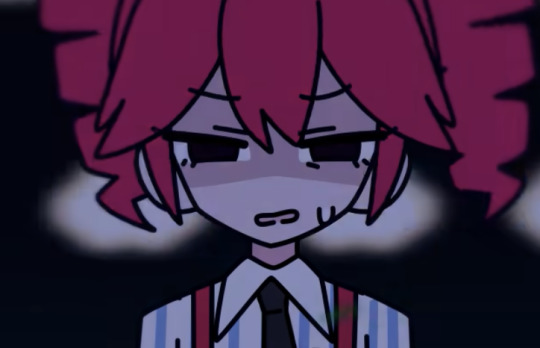
Even she falls into hypnosis.
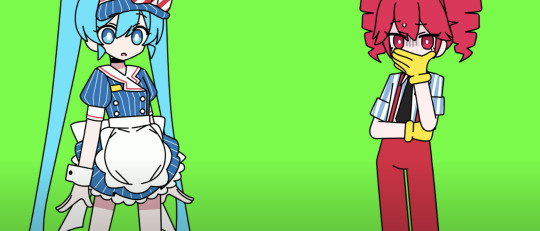
Also, their entire background is green here. Teto looks a little shocked, while Miku finds nothing wrong with this. This may be a green screen, which further emphasizes that the world that they are in is not real, and is only a product of escapism and/or imagination.
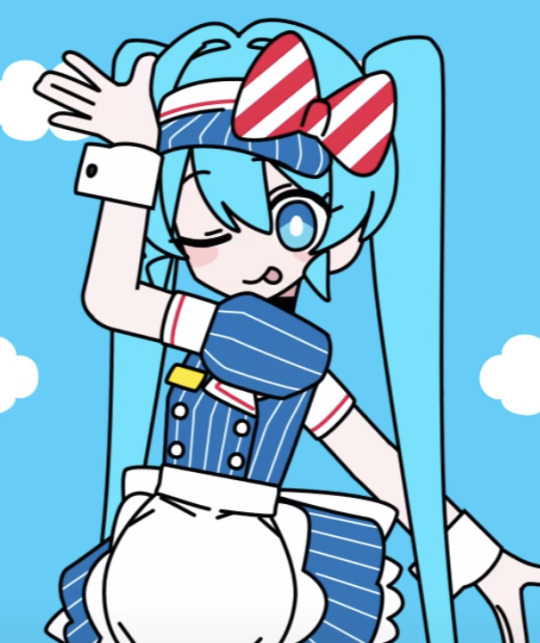
Miku has never done this pose before, until after she was hypnotized.
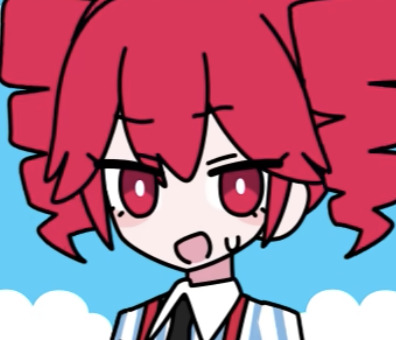
Also, it’s a good time to say that Miku’s movements here look robotic, or like she’s being puppeteered, with how jarring they are.
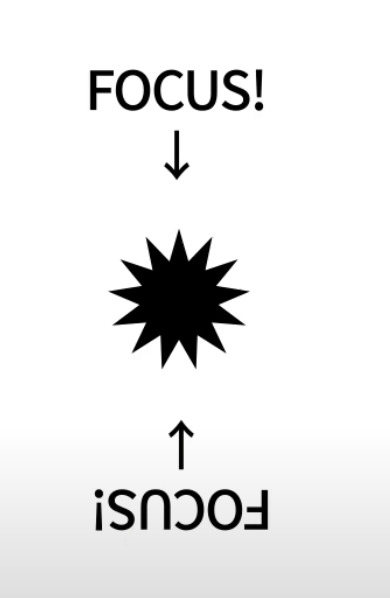
I didn’t point this out before, but this happens earlier too – they point at the star, and tell you to “focus”, before “MESMERIZER��� is spelt out really quickly in the star, at the very start, but not at the second time.
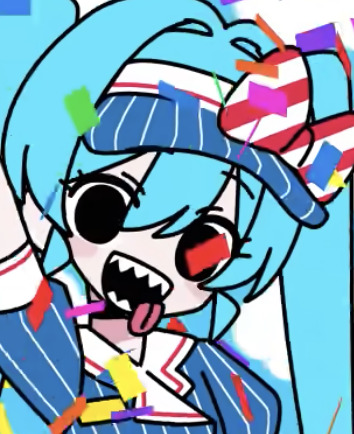
As we start the next chorus, Miku’s face develops into this. It’s also noted that Teto stops bouncing for a few moments in pure shock. Also, I should mention that after you hang yourself, your tongue can protude from your mouth. There’s also a choker around her neck, and her skin seems to pale considerably, which points to the idea of a suicide. However, if she’s dead, what is puppeteering her?
Also, the star at this point is swirling. It’s outright trying to hypnotize you.
However, after this, Miku continues to dance, even after her part is over, and even goes off beat. The amount of confetti in this scene is increased considerably, as if whatever is trying to hypnotize them or control them is trying extra hard to make Teto give in.
At the end, she does.
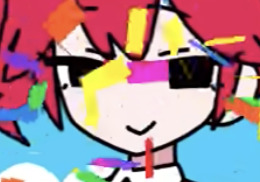
PART 3: THEORIES
So, what the hell does this all mean?
Let’s recap–
Teto & Miku are going to the unhealthy coping mechanism of escapism to deal with their lives, through one form or another, to run from reality. This much is clear. However, it gets to be too much for them and they are inevitably hypnotized by something or someone, taken control of, and while Teto asks for help, Miku gives in early, leading to the ending. This is all we can take from surface level.
This is where I get into it with my theories.
I like to mention the fact that these two feel immensely like they’re being conditioned by something, or someone, that they are supposed to trust. Maybe an adult figure in their lives. They clearly have faced hard shit during their lives, which explains the need for escapism. Teto is the more grounded one, and Miku just wants to escape from the pain. The first way that I interpret this is:
Childhood abuse. Both of them are being manipulated and coerced by their own parents, and are finding solace in one another. Teto brings up escapism to Miku, and they do it together, creating worlds together and having fun at the start. Teto keeps on trying to ask for help to the people of the outside world in miniscule ways, but even when she directly asks for help dealing with her situation, she is still ignored and pushed aside. So, they then escape whenever they can because it gives them a feeling of control when in fact their own escapism mannerisms are a way to try and control their real lives but it doesn’t matter because it’s better this way. So all of her “SOS”s are for nothing.
However, the longer the abuse goes on, the more they fall into it as their only method to be saved, and Miku eventually cannot handle reality, falling into the imagination world forever – that is, killing herself so that she will never have to deal with reality again, being pushed over by the expectations she had to fulfill in reality. Teto stays afterwards, however, trying to handle life, but is eventually manipulated into being something that she’s not, and kills herself as well due to the pressure. However, this could also be interpreted as a “loss of the self” as they either drown themselves both in the imagination world, or could be interpreted as the fact that they eventually simply turned into the people their parents wanted them to be.
I can also interpret this in a completely opposite way – that the world that is full of colours and whimsy is actually a world that their parents have trapped them in. That they are being pressured to be happy all the time even though they don’t want to be, and that in front of everyone else they have to act like everything is fine even though it isn’t. Maybe they’re being coerced by their parents to never feel sadness, to leave all of those ridiculous things behind, to become perfect – almost like a Coraline situation. They’re pretending like everything is fine even though it isn’t. However, eventually, they get caught up in all of their lies and the fake reality they set up for themselves. They’d rather look at it rather than reality, but at the same time, they are being puppeteered by their surroundings in a harmful manner.
Escapism. :)
Second interpretation: they are working for some studio or something, which could be why there was a green screen at one point. They are promoting the idea of escapism to other people, but unwillingly. Miku falls into the ideals of their director and falls into the headspace entirely, agreeing with the ideals of others while they are forced to continue spreading this message in an almost dystopian manner. They are hypnotized by the person producing this message.
Third: Maybe this is a story about them working in some sort of childhood theme park in order to escape their realities as well, and be children forever? This ties the two previous ideas together. They are overworking themselves to the point where reality and fiction are indistinguishable. Unable to deal with everything that she has to do, Miku dies, and Teto follows suit.
Four: Literal hypnosis. Maybe some sort of horror story of becoming victims of some hypnosis monster? I like this one the most because it makes me think of a story where Mikuy and Teto were struggling, and perhaps made a deal with some eldritch being so that they can escape reality into their own fictional world. However, as more time goes on, the more the world that they’ve entered becomes twisted, and Miku falls to the being’s whims, turning into a mindless puppet in order to reject reality further. Teto, horrified at what has happened, tries to reach out to others, only to have nobody listen to her. She then gives up entirely and joins her friend.
There’s a lot of ways to interpret this, but the general message is that people want to escape from their harsh realities. This is natural, especially if you’re a victim of manipulation or abuse, but this is also a reminder that you can’t go too far from it, and that there are still people waiting for you.
TLDR: Escapism, slay! But don’t slay too hard, unless you want to end up like MESMERIZER Miku!! I love this song so much and I can and will elaborate on ideas. I’m really tired due to my exams so I am so sorry if something doesn’t sound coherent here, but thank you for reading!! <3
#mesmerizer#vocaloid#32ki#mesmerizer 32ki#mesmerizer vocaloid#vocaloid analysis#analysis#song analysis#lyric analysis#media analysis#media#aurae analyzes#tw for abuse#manipulation#gaslighting#child abuse#escapism#unhealthy coping mechanisms#mesmerizer is the tw#neon colors#neon lights#tw for bright lights#idk what else to add#animation analysis#mv analysis#hatsune miku#vocaloid miku#teto#kasane teto
46 notes
·
View notes
Text
The tightrope he walks. The hall of mirrors that changes his image, depending on your perspective. He’s a strong man, but are those weights legit? Yeah it’s a circus, but it’s fun, he’s having fun!
The metaphors!!! It’s such an incredible insight into another view he has of his fame. Basically the foil of MFASR’s message. So good.
158 notes
·
View notes
Text
first things first.
CHANYEOL’S FIRST SOLO ALBUM „BLACK OUT” IS OUT. IT IS FINALLY OUT. FUCKING HELL, CAN YOU BELIEVE WE’VE WAITED FOR SO LONG AND NOW IT’S HERE AND IT’S BEAUTIFUL AND I AM SO PROUD OF CHANYEOL I HOPE WE GET TO SEE AND HEAR SO MUCH MORE FROM HIM IN THE FUTURE.
ok. now that that’s out of my system, let’s talk about the mv for black out. in depth. hell yeah.
(on a side note, i really wanted to make a post like this for a long time. like, a long post where i put down thoughts in a kind of structured way, so yey i am excited, let’s go.)
first, i want to point out that personally, i appreciate a lot that the song has no gendered language (as far as i know. i am not fluent in korean tho, i am basing this on the english lyrics supplied with the video!), and in tune with that i will also use gender neutral language in this little analysis here. the only case i will use gendered language is when referring to chanyeol, who i will treat like an actor portraying the protagonist in this video. so when i say “chanyeol” i mean the guy in the video and not the person park chanyeol – just for clarification. ok. now.
overall, to me, the mv feels a lot like a movie, or parts of a movie. it has amazing cinematography – the city at night, the bus ride, the scenes at the window of the apartment, the fish tank, the short scenes relating to boxing – that portrays the feelings around a breakup very beautifully. in the video, i see many symbols that represent specific situations and emotions and that’s what i want to break down here a little bit.
the cassette tape is probably the most obvious of the symbols. the cassette he literally clings to, i think, represents the past relationship itself. is the very first scene he is sitting on a bus full of happy people, people that seem to be in a romantic relationship, that have fun and are laughing – he is alone and surrounded by love. he simply sits there, unmoving between people that are eagerly interacting with each other. he is still while everything else is moving on. but he has the cassette which he doesn’t even listen to (notice how we never see him wearing the headphones he carries around his neck!).

he is not listening to the tape, just keeping it – the relationship might already be over, he is just holding on to the memories. he doesn’t want to think about them (or else he would listen to the tape) but also doesn’t want to lose and let go (that’s why he's keeping it). and that’s why he is very distressed when he loses the tape, why he holds on to it so hard. but in the end, it rips apart and that causes him so much hurt. it was so precious to him and tried to keep it so hard. it’s really painful and heart-breaking to watch.

the bus ride itself is very interesting because it starts out being a space chanyeol is… well, not exactly comfortable in. but it’s a place where he rests, where he sits and lets himself being carried along, unmoving object at a place where everything is moving a lot. he is, mentally, still very entangled in the relationship. that’s why he’s still on top of that bus, alone with all the other people that are so happy and loved. he hasn’t moved on yet. and he doesn’t seem to want to.

until the moment we see the cassette on the ground. then we see him suddenly realizing that he lost it, like snapping out of a trance. he gets up, wants to get it but it falls out of his reach, the tape comes loose, and he tries to hold on to it so much. the moving bus suddenly becomes a trap, it moves too fast and the tape rips in the end. he can’t go back to the relationship and the memories anymore because it has broken and it’s his fault in a way. maybe he stayed to long on the bus. maybe he realized it fell too late. maybe he acted too hastily. maybe he should have kept the cassette safe in a pocket so he wouldn’t have lost it in the first place.

the scenes of him running aimlessly through the cityscape could just be mindless wandering to keep himself moving, but i like to believe that he is not so aimless in his running. i think he is looking for the lost tape. i think that in all the stillness he wants while he still is holding on to his memories, he feels utter restlessness after losing them. everything moves so fast, everything is loud (there even is a fucking plane), there are lights everywhere – he is afraid he won’t find the tape again in the vastness of the city. and maybe he doesn’t.
for me, the scenes with blond chanyeol happen after the bus scenes. he is post-breakup chanyeol (because what do you do after a breakup? right, radically change your hair xD). that’s the chanyeol we see in the apartment with the fishtank and the chanyeol we see boxing (well, kinda. we don’t see too much of the actual boxing, but I think that will change once we get the mv for back again xD). it’s also the chanyeol who is looking at himself in a broken mirror.

mirrors and reflections are symbolically used to reveal the true self of a person, in chanyeol’s case that’s someone who feels very broken inside.
something that really stood out to me was a shot of the fishtank where they filmed the tv in the background of the apartment through the water.

first and foremost, the shot through the water gives the whole scene a very whimsical feel, like looking into a dream world that chanyeol is escaping to from the harsh reality of his broken heart and the end of this relationship that he treasured so much. he is literally pushing his head into that world, into the water, where he can’t breathe.

that’s also a very desperate act of trying to feel alive, or like… anything at all. the same reason he resorts to a painful sport like boxing. the physical pain fills the emptiness that remains and overshadows the emotional numbness, fills the lack of emotion with pain he can control, instead of letting himself feel the emotional pain he can’t control. (and on an important note: both actions are forms of self-harm and that’s a very unhealthy coping mechanism, just… don’t do it)

back to the fish tank. fish can symbolize change and adaptability, as fishes are animals that can survive even in challenging conditions. and that fits very well with the story of the mv as well. chanyeol still needs to figure out how to adapt and how to survive his life right now, but he will figure it out – just listen to the rest of the album, and especially back again! as this is the other song we’ll have an mv too, and one that picks up on the boxing element that was introduced a bit, i treat it like what happens after the black out mv / the breakup.
back again is a crazy song!! it’s very lively, full of sounds and little details, of versatile voice use and a lot of energy! it’s him bouncing back again (see what I did there-), it’s when he is feeling better again and is confident to move forward again. and maybe he’s a bit more enthusiastic than he is actually healed and fails. but he has hope and takes moving on and coming back to life step by step.
musically, black out feels more like being torn apart from the inside. there is a lot of vulnerability in his voice while the beat is very restless when all we see chanyeol do is wanting to hold on for a moment but the beat and the melody, the song itself really, pull him along.
i also noticed to the colour schemes in the video. mainly we see a dark blue being used. in some moments, very prominently the scene where chanyeol looks at the goldfish in the tank, a warm orange is used as contrast.

it feels very comfortable and, well, warming within all the cold blues and greens, so that sort of underlines my interpretation of the fishtank scene(s). i also noted that in scenes from the apartment we see pink lights, usually contrasting a greenish blue light. neither of those are very warm lights and add more to the general vibe and atmosphere of the scenes, i think. one could argue though that pink could symbolize love, which is a pretty obvious although not happy theme of the story.

this mv has so much pain and regret and yearning and so so so much hurt. in all the soft spots. it’s dark and gloomy that make it feel almost brutally real. i like to draw a parallel to tomorrow here (and not only because the two mvs use similar a similar colour sceme, blue and orange), which is very still and very in the moment. it’s also dark and yearning but is gives these feelings room and holds a glimmer of hope. black out is not that calm. its darkness is hurrying the protagonist along, who just wants a moment to hold on and breath. but there is no room for feeling those feelings in black out, but there is no way to outrun the pain. or the hole in your heart that’s left when you lost something you loved a lot.
[watch the mv here]
[listen to his album, including back again, here]
#chanyeol#exo#park chanyeol#loey#chanyeol black out#chanyeol solo album#exo chanyeol#pcy#kpop#kpop mv#exo mv#chanyeol mv#mv analysis#media analysis#music video analysis#random starchild noises#headphones on 🎧
11 notes
·
View notes
Text
shout out to that one section (starting at 2:29) of the キティ (kitty) mv in which the camera pointing at mizuki and mafuyu change for a moment to represent their younger selves.
the fucking expression of mizuki with short hair, looking at themselves, terrified. HOLY FUCK... that dysphoria feel so real lfkndlsfknaksl- and it does feel like it represents the trans experience of feeling like your past self have came back to haunt u so well... and even now with their long hair (pictured with my new pfp) they look so incredibly yearning, yearning for something, for something they feel missing. ARGHHHH IT'S SO REAL...
and mafuyu too, kflnlnal, the camera shifting to her young self with the teddy bear, seemingly having an innocent yet melancholic expression. ARGGHHH it also shows how we idealize our childhood, yet when we look closer back to our childhood... that darkness always have been there...
PROJECT SEKAI HOW DO YOU... YOU'RE THE FUNNY HATSUNE MIKU GAME... HOW DO YOU.. CONVEY THESE EMOTIONS.... THESE EXPERIENCES.- SO WELL. WHAT THE HECK-----
youtube
#mizuki akiyama#mafuyu asahina#prosekai#pjsk#prsk#project sekai#nightcord at 25:00#niigo#25 ji nightcord de#mv analysis#キティ#kitty#tsumiki#ツミキ#Youtube
37 notes
·
View notes
Text
txt makes music that gay people (using as an umbrella term) (myself included) love, so I'm gonna list all the times I can remember their music and music videos being queer-coded off the top of my head.
disclaimer: this is not me assuming anyone's sexualities!! when discussing music videos and using member names, I am referring to the characters they play in the video and not the members themselves.
the 0x1=lovesong music video. holy shit. show this to a queer closeted teenager and they will go absolutely feral. I saw a twitter thread once (when Twitter wasn't locked to people without accounts) about all the queer-coding and it made me lose my mind. I don't have access to Twitter anymore, but from what I can remember, there were a lot of references to Leslie Cheung films. The one example I can remember is the scene for the bridge where Yeonjun dances in front of the other members. also the lyrics??? "I'm not going to get into heaven" oh my god. also again with the bridge, literally everything about the pair dance (and then saying 'girl' as if that would somehow make it seem less gay lmao).
2. the loser = lover mv. Literally everything about Beomgyu's storyline. Gender non-conforming teenager and the only member without a (moa self-insert) girlfriend (but with daddy issues lmao). Also "with you even a fall is beautiful" what if I Cried.
3. poppin star. granted, this is more of a meme than anything else, but if you've ever seen the "txt songs gay as hell so they've got to add a little gendered term to spice things up, because why are the lyrics like "we must keep this a secret our love is illegal in 56 countries- GIRL" tweet, this song is what the tweet was referencing. literally one of the lyrics is "isn't this perhaps something that the country has allowed/something that we have hidden/alright, it's something that's not allowed for just anyone/try popping a whole mouthful" like WHAT? I still have no idea what that means.
4. devil by the window. uhhhhh they're getting tempted by a devil with male pronouns. really the whole temptation album is kind of gay if you look at it through this lens.
5. sugar rush ride. I don't even have any specific examples tbh. everything about the lyrics.
6. crown. a song about feeling like a monster, but meeting someone who's the same as you and learning to accept yourself. shout out to the lyrics "would there be forgiveness?/even for the devils?" and "nobody can understand/but it's you/your life changed my world like magic"
this is all I remember for now, but I'll edit this post or make a new post if I remember more. feel free to add your own in the replies or reblogs!
#0x1=lovesong#loser lover#poppin star#devil by the window#sugar rush ride#txt#tomorrow x together#queer coding#lgbtq#lyrics analysis#music video analysis#mv analysis#crown#crown txt#txt crown
11 notes
·
View notes
Text
WORK MV First Reactions
Yet another ATEEZ music video released while I'm at work - love it....
Another thing I'm not keen on is the song itself. I haven't been super impressed with several of ATEEZ's new title tracks, musically. Luckily for ATEEZ, I don't really follow them for their actual music (although it is a shame that the newer stuff hasn't been my style). I'm especially unimpressed with the chorus, which reminds me of a combination of Australia's anthem, Down Under, and Bills, neither of which I am super keen on... I know ATEEZ's recent comebacks have been less serious, but... this just doesn't suit them in my opinion.
Luckily for them, their performance skills stand up, regardless of the quality of the music.
This MV is definitely more of a filler one - it has a lot of ATEEZ motifs and follows the story from the previous MVs, but doesn't add much else. I don't have that much to say about it, but let me say it anyway! Full analysis below the line.
So this music video seems to be mostly a lot of motifs to show that ATEEZ are becoming more and more successful, and that, through hard work, they will become even more so.
We can see this through the copious amounts of money they make, the copious amounts of work (or more like party-work) that they do, and through the MV showcasing signs like the Billboard sign. Seonghwa riding the ostrich at the beginning is another example of this - he has many different country flags in his bag, showing the many places ATEEZ have gone and will go.
This music video also continues thematics that originated with Dont Stop - first, the cowboy concept and 'Wild West,' which has ties to the anarchy that they're trying to create in the oppressive world of Strictland (omg change the name please ATEEZ I'm begging you). See my Bouncy analysis for the Wild West stuff.
We also get what I presume is the extension of the drug dealing in Bouncy and the heists in Don't Stop - the expansion of ATEEZ's business empire, which they will use to take over the world with partying and music.
I don't think there's anything super interesting visually story-wise which would require screenshots - Jongho being in the ground is a fun gag that shows how ATEEZ are fun, how they can literally work themselves into the ground, and is possibly a reference to Down Under, which has a man in the desert playing a flute-like instrument.

I mean, this is the only thing that I am aware of that it could be referencing, and this song is pretty famous as far as I know, and suits ATEEZ's themes well, but if you think it referenced something else, let me know.
The animals (mostly birds) vibing along to the song continues the animal imagery from Bouncy and other songs - even the animals will party along to ATEEZ's music, and of course, we have the golden eggs and the blessed hens which lay them - a symbol of wealth and also good fortune.
There's also the general outback imagery which contributes to the idea of the wild west, the office that Yunho and Yeosang occupy which shows work, sophistication, possibly some shady dealings, and so on. And the Motels show travel, which they are of course doing for their literal jobs.
I do like the scene with Hongjoong and Mingi looming over a city and showering down so much money that a money monster appears.

But it doesn't really have much deeper meaning as far as I can see - like, even if we consider it in relation to the Strictland storyline, it just shows that their presence looms over the city, and that they have tons of influence, perhaps even more than the Guardians and the government who occupy the tallest building.
Interestingly, as far as I can see, Hongjoong's armband doesn't appear in any of the scenes in the music video, although he does have his usual coat and cane.
The rest of the vide is just things we've seen before - the cars dance because the power of ATEEZ is so strong that even inanimate objects will work. The 'game over' screen when Hongjoong falls out of the car is reminiscent of the comic scenes in the Crazy Form MV... I just... did not find this music video particularly interesting or compelling. It doesn't feel like it has high production values, and it feels a little like it's trying to milk the virality and success of other music videos like Bouncy - but it just doesn't have what Bouncy does :( I can't even find any exciting Easter eggs or story tidbits in the props - like even the newspaper Yunho holds doesn't seem to be anything exciting. And although I'm sure they meant something by Seonghwa coming out of the egg, I'm not sure what, and I can't think of any potential storyline references.
Anyway, moving on to something that I was generally more happy with;
Lyric Analysis
Most of the lyrics are pretty standard and expected from this kind of song - about how cool and hardworking ATEEZ are and how successful they will be in the future. But there are some interesting things to note/ATEEZ lyrical motifs;
San saying that when he makes a move, the Guardians follow him.... like? Hello? What a massive potential storyline drop in the middle of this causal line. The reason this is weird is because there isn't really any other potential meaning of 'Guardians' here that makes sense that isn't the Guardians in the fencing masks. And it makes sense that those Guardians would follow them when they make a move, since, well, the Guardians are hunting them.
The Real is referenced in Hongjoong's rap - since they are the Real people, ie. genuine
Bright and blinding lights
Burning
Everyone dancing and getting involved
Everyone being unified as one humanity
Being unique and individual (this makes sense since in Strictland people can't be individuals)
Time
Fun fact, the phrase they say in the prechorus that I assume is in Spanish (Ganso que pone huevos de oro) apparently translated to 'goose that lays the golden eggs' or something similar - which, yeah, that makes sense, considering the music video.
Conclusions
It was pretty filler imo. It continued a lot of motifs from previous MVs and stories, but it didn't do anything unique or special itself, except for bury Jongho.
That said, it does seem to be building up to something where ATEEZ get power - a bit like a training montage - so my current prediction is that the next comeback is super storyline-heavy and super Gothic - because ATEEZ can (thankfully for me, based on their track record0 never stay away from the Gothic for long.
I mean, WORK is catchy - but so is almost any song that has a repetitive chorus.
7 notes
·
View notes
Text
Like you ever think about how when V looks through the camcorder, being blind in one eye, the only thing he can see is the alternate reality it shows him? On the other hand, IU is always half stuck in reality. At the end she keeps her eyes open while covering V’s eye. IU faces reality so V doesn’t have to, she’s been protecting him the whole time 🥹

#love wins all#love wins all mv#love wins all IU#IU#BTS V#V BTS#kim taehyung#lee jieun#own#mv analysis#music video analysis#love wins all analysis#analysis#jams bts tag
10 notes
·
View notes
Text
'Chasing That Feeling' MV First Reactions
Guys, I'm reacting. The blog isn't dead. I'm just also going to the Wild Kpop Fest in Sydney, so had to get ready for that. It was fun and I enjoyed seeing all three groups, but especially New (ahem, bias altert, ahem).
But let's have a look.
First, this MV pretty obviously follows on from 'Good Boy Gone Bad,' 'Sugar Rush Ride' and so on. It also has what I interpret as some nice Magic Island references, but I may be completely wrong (as always). So let's get into it!
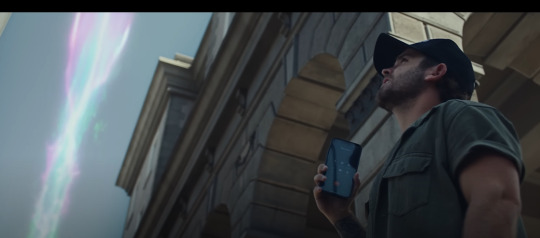
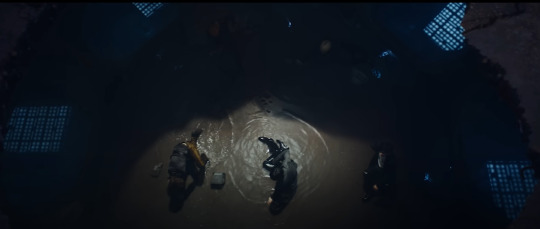
I feel like this ray of light depositing TXT on Earth is a pretty obvious representation of them being expelled from Magic Island. It shows how violently they have been expelled after abusing their power, and it conveys how they, like Gfriend and unlike BTS, were born on the island, as such, and thus are basically supernatural non-human beings.
Also, the rubble and water are reminiscent of 'GBGB' and the Japanese MV for 'Sugar Rush Ride' - instantly visually connecting this storyline to the heartbreak and insanity one which those MVs discussed.
And, of course, we have the continuation of the star and the number 5 - there are 5 tunnels leading out of this hole, 5 colours in the light, 5 lights they chase, 5 points on the star, and so on.
There's also a nice contrast with the idea of angels coming down from the sky, and TXT being dressed in black - reminiscent of when they went crazy and were decidedly not angellic, despite being supernatural.
This is also emphasised by the fact that they are styled with tattoos.
Also, as always, TXT's choreographies are great.
Don't ask me to colour analyse the colours of light each membr chases - it would take far more time and research than I have today to do that in depth, and is thus better suited for a proper MV analysis. The most I can say so far is - Kai is gold - since he is the 'angel', Gyu has been associated with green before, especially in the webtoon through plants, and Yeonjun gets the other side of the cat - blue and green, thus he gets green.
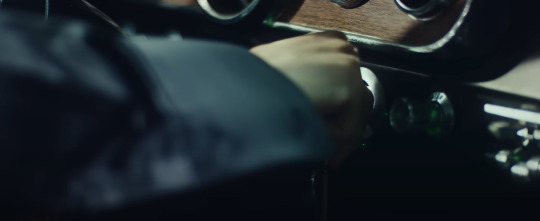
A lot of this MV is them further abusing their powers, since they clearly didn't learn their lesson. Also - note that there are a lot of cars featured in this MV - cars being something we have seen in Magic Island arcs before, and which is generally a symbol of transit - as TXT are continuing their journey.
Interestingly, only Gyu, Yeonjun, and Taehyun seem to actually attain their power in this MV - Kai and Soobin are just constantly chasing it. We know Kai is in an internal battle, so it makes sense why he chases. Soobin is also being held back by doubts and the glass box the cat put him in. Yeonjun, Taehyun, and Gyu are all very firm in their beliefs - whatever those might be, and whether they're good or evil - so they can grab that power and feeling since they know how.
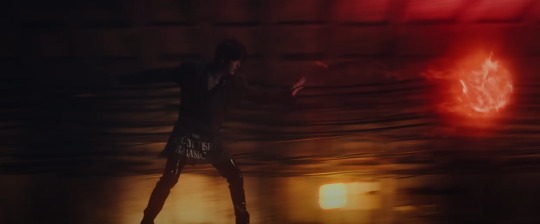
Trains are back - another way to get to Magic Island. They also emphasise the sense of danger in this MV.
Also, are you wondering why no one - except for the people Yeonjun LITERALLY RAN INTO are reacting to them in this MV? I'll discuss that more later.
I also think this scene is the best visual representation of the longing and desire they feel in the MV - Soobin reaching forward for power, for love, for literally everything he could ever want, but forced ackwards by the momentum of the train and his own doubts.
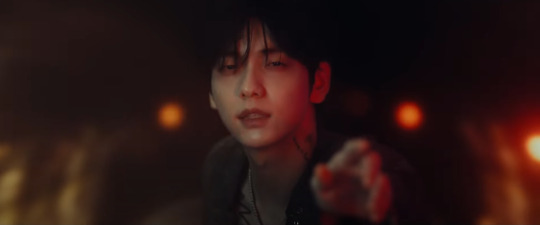
Like, look at this face!
Also - note that the tattoos on his neck look a little like the branches/veins V had on his neck during 'ON' era - a coincidence? Idk, but it's interesting.
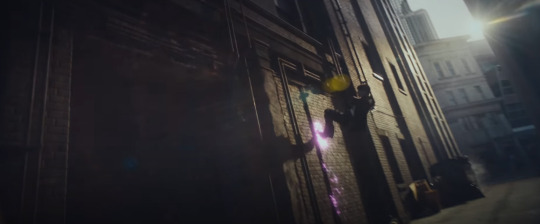
So here we see that Taehyun has his power, and, like the rest of them, he is wonderfully misusing it.
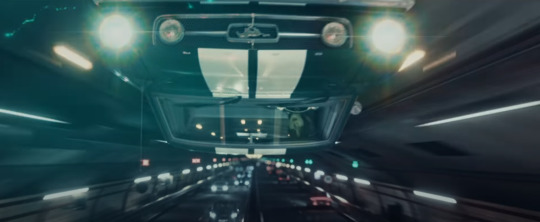
Same with Gyu - although in a far more dangerous way.
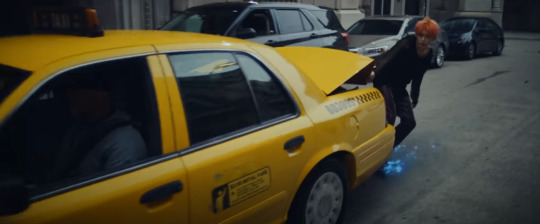
Yeonjun too.
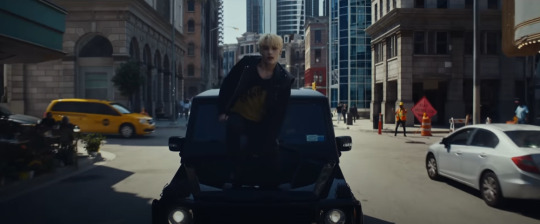
I'm not entirely sure if this is supposed to be Kai having his power or just grabbing a lift to try and catch up to it - but since there's no golden light, I'll assume he doesn't have the power.
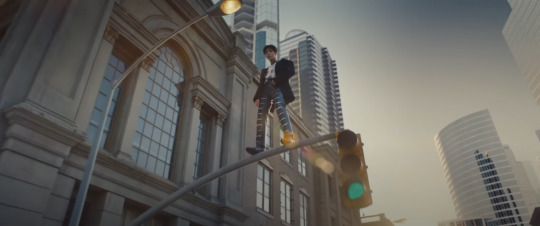
I don't think this has any point other than to show how he's cool, how he's using his power, and possibly associating him with Gyu considering the light is green.
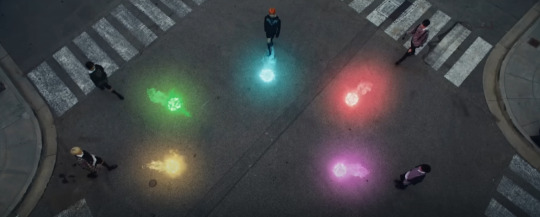
Star time again!
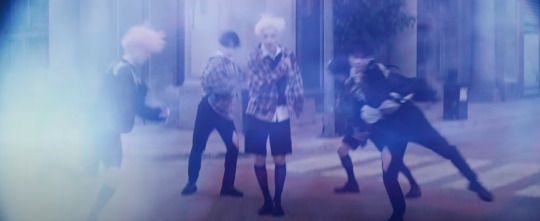
They've unified - making them more powerful, as expected. But interestingly, in this explosion, I only really see the red and blue, and, by proxy, purple. Was there a reason for this? Soobin, Taehyun, Yeonjun - generally but not always portrayed as good - vs Gyu (who smothered Taehyun) and Kai (who has a demon inside him)? Maybe I'm completely wrong.
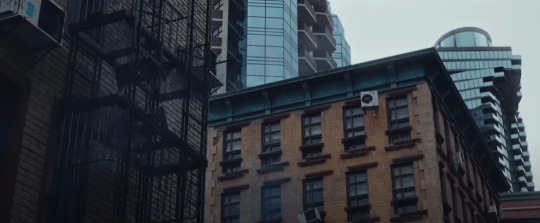
So the Dr Strange stuff going on here is interesting because it shows that their abuse of their powers is literally breaking the universe/breaking reality. It also made me think that they were moving between dimensions - you know, since it's the mirror dimension. Which brings me back to people ignoring them and the light falling from the sky - it's possible that they have been shoved into another dimension, either by their own volition or because of the harm they did to Magic Island. This is a nice use of visual shortcut and also offers a potential explanation for why they are suddenly in some random city in America or England - I thought it was London but my knowledge of these places is almost nonexistent so please forgive me for not knowing.
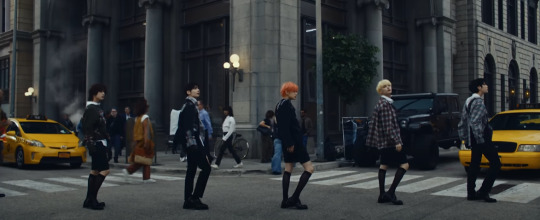
I also find it interesting that they suddenly snap back to reality.
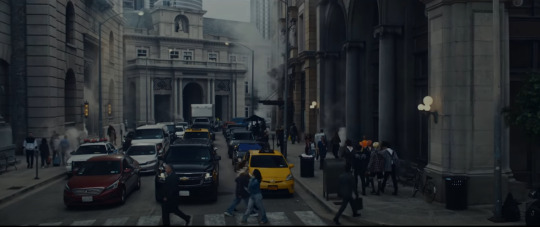
And also an odd shot to end on. The only thing we would think we would get from this is seeing the boys leave, but we also see the cars, the people walking, and the buildings. I have no doubt there is hidden meaning or are hidden detailsl, but the only thing I can really point to is that it reminds me of 'My Fair Lady,' and that the steam rising up could be considered the damage left over from the world knitting itself back together after going all mirror-dimension.
So that's the end of the MV!
I love the choreography, as always, but that is best analysed in a different video. Interestingly, I think it does little (compared to their other choreos) to tell the story, and instead is just cool and portrays the mood of the song.
Let's talk about the lyrics for a moment.
We've of course got the mandatory mentions of the night and moonlight, and of the highs of being in a 'loving' relationship.
The 'thief that keeps on stealing' is interesting, because there's the obvious meaning of 'stealing my heart,' but also the implied meaning of stealing power etc.
Then of course, the idea of miracles. Lightning is also often associated with a dangerous form of love (See Romeo and Juliet for what is probably the oldest example of that). And the kalidescope and butterflies are of course related to the butterfly effect and the fracturing of the world through the mirror univserse/dimension.
And that's pretty much it. A nice simple set of lyrics for a short little song.
Conclusions
It follows on from the previous MVs and storyline. Although slightly different themes are explored in each MV, they seem to be very obsessed with the 'high' phase of the relationship, rather than, you know, the fallout and the healing from it. Maybe they're serially dating toxic people. Psychologically that would make sense. Storyline-wise? Not so much.
That said, they probably like keeping the romance for the title tracks since that sells well, and keeping the funky mind-bending curse stuff for award shows and bside MVs, since the fans love that, and it makes jaws drop in award show season. In fact, they released this basically just in time for award show season - was that for a reason? Or is that a conspiracy theory of mine?
As a matter of interest, this (generic title tracks and crazy bsides) is something that exists in the whole industry but ESPECIALLY in HYBE.
#txt#tomorrow x together#txt theories#mv analysis#the name chapter#tnc#the name chapter: freefall#chasing that feeling
7 notes
·
View notes
Text
Samidare
I'm unsure if this is supposed to be a real comeback or not, but it's still interesting so let me make a quick little text post :)
'Samidare' means 'early summer rain' - which I think is reflected in the MV well. This is the spring/summer follow up to the winter from 'War Cry.' It's also a very pretty MV which would make me feel far more emotions if I had a better understanding of what was going on. Probably need to wait for the MV reaction to get that information.
Samidare when googled shows up two main things - a Naruto soundtrack and the character Samidare (an opportunistic and curious person, apparently), and the Japanese destroyer Samidare, which was launched in 1935 and sunk in 1944 in WWII. I don't think either of those are related to the MV but they are interesting fun facts.
The MV itself is the contrasts between grief and catharsis - kind of like the 5 stages of grief. When the boys have reached catharsis and understanding, they are in the classroom blooming with cherry blossoms, and the summer rain falls - but when they are distrustful of each other, are doing things behind each others' backs, are in the midst of arguments and grief, etc, they are in a darker, gritter world - represented by the fight in the field and the crumpled photograph.
There's also the grave shown at the beginning - which is to a 'Giri,' who I presume is K's mentor shown at the start of the 'Under the skin' MV. The monument to him is grounding, and resembles the cliffs and rocky surfaces in 'War Cry,' which were, in a way, an outward representation of K's grief - since he was the member most associated with them.
The first cherry blossom blooms near the grave - possibly 1) showing Giri looking down on them, and 2) showing how we can move on from grief, and that spring and summer always follow winter.
Everyone gets to be angsty in this MV, and it would make a great short drama (like 10 half hour episodes or something), but we know HYBE's never going to do that. Fun fact, the people who I think are the most angsty are EJ, Nicholas, and K. Why these guys? Idk - K is obvious but not so much the others.
I literally gasped when they started fighting at the end lol the punch Nicholas threw looked savage.
And the lyrics are very pretty (as expected, &TEAM).
And on another note, I really like Nicholas, and he is very pretty.
Thanks for coming to my TED talk.
2 notes
·
View notes
Text
Top Songs from Enstars 2023
Number 3- Colors Arise
Boy, what a weird year for Ryuseitai! They got 2 new song events in a couple month stretch...including one that was after the Climax events started, but not a Climax event? And the first one we had this year actually feeling like a Climax?!?
The way Tetora has been handled in !! era has been...weird, to say the least. At the end of !, he is passed the mantle of Red by Chiaki...but that doesn't last. He gets the red outfit in Motorshow (with Chiaki donning Orange), but after that...Chiaki is back and always Red. We never got a Ryusetai unit outfit in Red for Tetora, and then Comet Show happened and Chiaki was back, and it was as if Tetora as Red never happened.
Flash forward 3 years, and we get our resolution to this in Color Arise. To make a long story short, Tetora remains black, but the logo has changed so that Black is now in the center of it, showing the Tetora is now the leader. It's not exactly what I wanted, but it does firmly resolve the story of who the leader is.
The reason I really wanted to talk about this is because of how amazing the MV is. It takes the Sentai themes of Ryuseitai and makes a mini-movie out of it! Going to a mysterious world, encountering a hostile lifeform that traps all of them, only for Tetora to escape, free everyone, and then teleport back to a dying earth and healing it, and then performing a concert! The highlight of this entire video, to me, is the teleportation sequence, and how the idols "land" on the stage. It's an effect that can be done in real life with light projection and a trapdoor/raising stage, where the video plays on the big screen, and when they "arrive" the light beams shoot down from the ceiling and then the idols "emerge" from the trapdoor. It's the kind of effect you would have seen from the era where groups like The Backstreet Boys were the biggest music acts in the world and doing giant, Taylor Swift-style world tours. It fully fits with the kayfabe/fantasy of the unit, while being something practical.
My closing thought on this is....why wasn't this saved for the Climax? The Climax is going to be a Kanata centered song, which is a bit weird to me, as the story of Ryusetai has always been about Chiaki, and then about Tetora. This....was the conclusion to that story. There isn't anything else to Climax!
11 notes
·
View notes
Note
Thanks for linking the daylight stuff!
Your takes were SO interesting, especially connecting the sad clown to his Halloween costume and spotting the tarot reader in the back. I think he had a tarot station at his Halloween show!
The video has a weird energy to me because it somehow feels like he’s in the middle of the late night talking and as it was narrative, as you said, but also like he’s turning a new page. It was also made in the middle of this era but only came out now.
do you think maybe he’s looking for a way out of the circus or has given up and accepted it? The horse imagery feels really final from your analysis tho I believe the death card represents change?
Brooooo 🤯
So we discussed here somewhere (probably deleted) about the bird and the fish right? How in the first album the bird is looking down at him in water (the album cover) and then the second album is fish eye and the last album is upside down. Holy shit. The sky and the sea mirror each other and look the same upside down. The reason the ocean looks blue is because it reflects the sky.
Anyway, so I’m on instagram and I come across this quote from Ever After “a bird may love a fish, but where would they live” “then I shall have to make you wings” and it all fucking clicks. Guys, the bird and the fish—daylight and golden/adore you. In MFASR he is a fish. Did he try to become a fish and a bird only to still be Harry?
Ever After is a retelling of Cinderella, the fairytale where a prince meets a low status woman who is kind and falls in love and then searches for her throughout the kingdom… are you all seeing the parallels now?
Anywho, just made that connection, kinda curious it connects to Cinderella, but he is Prince Charming/God of Love. God it’s so mythic isn’t it?
So back to responding to your ask… yes he did have tarot, the moon and the fool card at Harryween.
Yeah there is a feeling of chaos in all the music videos, like fast moving, lots going on. I feel like the energy of the Daylight mv seems to me to be a continuation of LNT. If we were to put the videos from this album in chronological order (sorta) I’d think it’d be MFASR, LNT, Daylight, As it Was. At the end of LNT he’s falling and in the beginning of Daylight he’s coming down into the circus. It’s a circus in his dreams and reality, you could see Daylight as showing he’s gotten deeper into the circus.
The death card is a card of transformation yes. The ending of something, an era. To me it’s Pluto vibes, you lose so you gain. You sacrifice something now for a better thing later on. Very much those vibes. For him, he’s accepted he’s lost something, sacrificed something for this career he wants. At least that’s how I read it.
I didn’t really see the death card in the horse shot. But if so than we’ve had three tarot card instances— 0 the fool (beginning of a journey, naïveté), 13 Death (end of a journey), 18 the moon (emotions, dreams, illusions). Kinda interesting he put the fool and the moon together. It symbolizes to me what we’ve been discussing about him evolving.
Anyway! There’s my thoughts.
7 notes
·
View notes
Text
This is all about Jimin disassociating at the bathroom
There is a lot of theory about Jimin's song Like Crazy is about his gender journey and self acceptance, we already knew that. However there is one particular scene that reminded me Jhope EGO and it leads me to the bathroom, a very sensitive topic to the trans community.
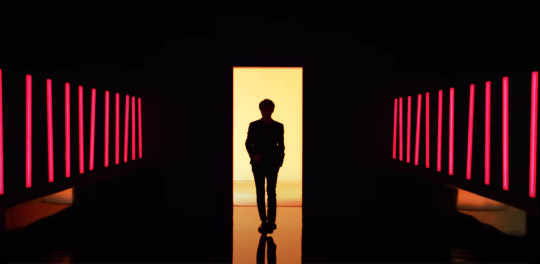
Here Jhope looks himself at the mirror, turns his back, moves his closet way and behind it there is this very clear, broad, plain hallway. The mirror part represents the way he views himself and his gender identity while the corridor is acknowledgement of his shadow to access his self and ego (the final destination of Map of Soul).
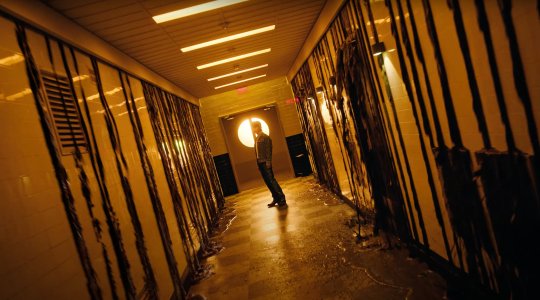
Unlikely Jhope, Jimin's corridor is being filled with dirty, later is just narrow, another time there is people blocking his way to his self.
This is a very good visual representation on how hard it to queer and especially genderqueer people come in term with themselves because of internalized trans/homophobia (the dirty), or epistemic injustices, or/mainly because other people actions upon oneself or the community as a whole.


While Jhope's corridor had no other visible place to go, Jimin's corridor has a genderless bathroom sign and two doors (two bathrooms?), as a middle point in his own shadow. It might be implied that the bathroom represents his anima/animus, also his gender identity is emerged into his shadow, the part of himself his persona doesn't show.
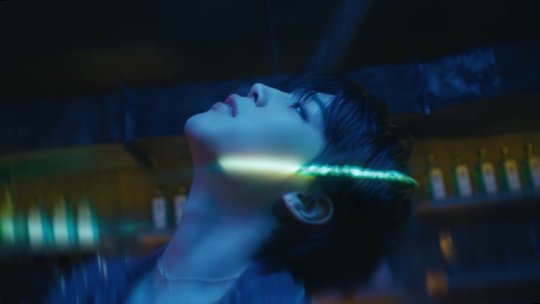
The party and the alcohol are ways Jimin creates to numb his mind, his shadow. As the club is a public space, he is also using his own public persona as a way to scape from the deepest parts of his inner self. However it doesn't matter what he tries, he will end up finding her, his female part. When they start to look for each other, Jimin body is scanned - euphoria/dysphoria in art form - as they look at each other like a mirror.
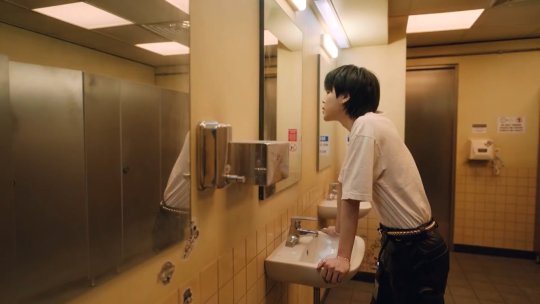
The bathroom
Public bathrooms are designed to control people's bodies. Those places has a very efficient gender technology in their architecture that makes everyone revisit their own gender as binary all the time. So public bathrooms are latently violent to gender nonconforming people and all kinds of transgender people to stay in.
The bathroom still violent place to Jimin as well, as he left it implied when he sings that his reflection is letting he "endlessly crazy". To safely be in a public bathroom you must pass and it's fairly easy to notice by his works how Jimin once tried hard to conform.
No wonder is the public bathroom where he disassociates from his reality: this is where all the self and socially imposed pressure related to gender probably will culminate.

Dream
Usually dreams are used as a escapism metaphor and in this song might not be that different. However the fact of one of the lasts verses says "I need a way we can dream of" dreaming sifts its meaning to believing in some (extra) personal change. The dialogue in the music' begging is about dreaming of changing while negotiating with the fear. Like crazy was always a great bargain.
This change eventually happens in the mv, the bathroom reassembles as Jimin is not in there. This is part of his self acceptance, personal changing and growing process, but it doesn't go without consequences.
As he returns to that room (his ego?) the dirty is not all over the floor anymore, but in himself. "Alone again. What's the point?" This time Jimin is conscious of his gender identity but that one question remains. As I also see Face as the five stages of grief, the next stage is depression or "Alone".
#jimin face#bts jimin#gender stuff#genderqueer#gender nonconforming#queer#mv analysis#gender identity#gender dysphoria#face analysis
15 notes
·
View notes
Text
She is literally spilling rainbow paint at the end of the video after wearing a gay ass suit short combo with cowboy boots at the end of the mv.
If it was anyone else, yall would have been accepted the bitch as queer tbh.
#everytime i think about how yall were like is lil nas gay bcuz of a tiny ass rainbow in the back of a mv#i want to fucking scream how do u yall look at lover era and not see the gay#taylor swift#gaylor#lover#me!#mv analysis
14 notes
·
View notes
Text
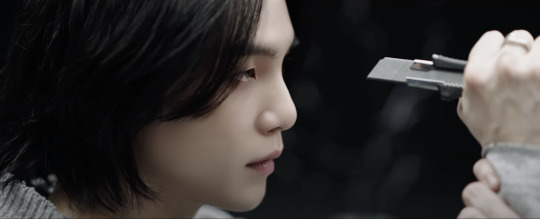
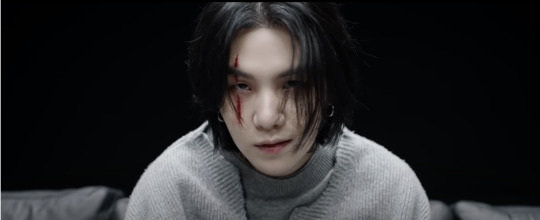
I think the knife (or maybe a piece from the motorcycle?) that he holds is possibly a metaphor for the numerous traumas mentioned in the song's lyrics, as well as the motorcycle accident that is depicted in the video. In addition to that, it could also represent his sometimes self-inflicted fear or destruction which ultimately gave birth to Agust D, who Yoongi has mentioned is a manifestation of things like fear, regret, grief, etc.
10 notes
·
View notes